I am so proud of my kids (and myself!) for surviving our first family backpacking trip! Not only did we camp in the backcountry overnight, but we also had to hike a grueling sand “trail” to get there. I grossly underestimated the effort required when hiking in sand, especially when carrying an overnight backpack. While this was a challenging hike, it was well worth it for the solitude, the views, the epic sunset, and the family experience. If you are considering backpacking Great Sand Dunes National park with kids (or without!), I’ve compiled a complete guide with planning and packing tips, as well as our route and description of our experience. If backpacking with your kids is not a challenge you are up for (yet), I have also included some non-camping, family-friendly activities to explore in Great Sand Dunes National Park, including Medano Creek, sand boarding and sand sledding, and a trip to Zapata Falls.
Great Sand Dunes National Park is located in Mosca, Colorado just north of Alamosa. It boasts North America’s tallest sand dunes—750 feet from the base to the summit at nearly 9,000 feet of elevation. The park is currently open to visitors with no restrictions or reservations. Get the most up to date information here.
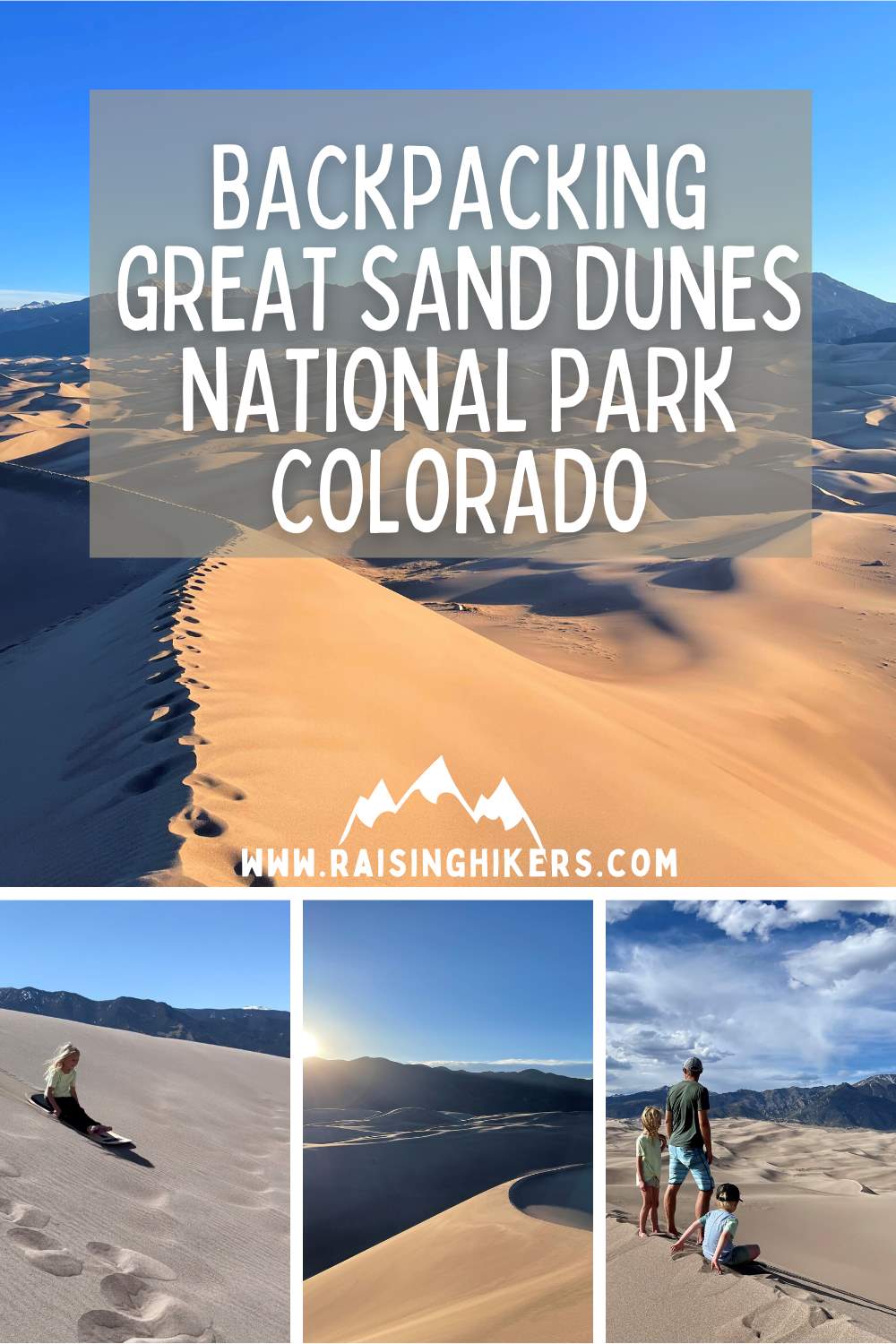
OUR EXPERIENCE AND HIKING STATS WHEN BACKPACKING GREAT SAND DUNES NATIONAL PARK
The beauty of this backpacking trip is that you only have to get beyond the day-use dune area in order to reach the dune field backcountry. This can be as little as one mile to get over the front dunes. Once beyond that point, you can camp anywhere in that backcountry area. This short distance was what enticed us for our first family backpacking trip since this would be our kids’ first time carrying overnight backpacks. However, once we got back there we were eager to find the “perfect campsite,” so our mileage was a bit longer than expected. Regardless, I would recommend that you expect at least 2 miles of hiking in sand as opposed to the “1 mile” you may read elsewhere as there is a lot of gain and loss when traversing over the dune fields. And the initial elevation gain in the challenging sand makes the mileage feel more severe than what you see on paper.
- Miles: ~ 5-6 miles roundtrip, but we did not track the return hike since we sledded some of it and took a more direct route down. The hike to our campsite was 3.3 miles one-way.
- Elevation gain: 1200 feet, max elevation was 8,575
- Difficulty: Difficult
- Type: Out and back
- Time: 1 hour and 36 minutes of moving time, but 3 hours total time on the dunes including breaks while trekking to the campsite.
- Dog friendly: Yes and no. Dogs are welcome in the dune field, but not for overnight backpacking.
- Campfires allowed: No
- Bathrooms at trailhead: Yes, but of course practice Leave No Trace principles while in the back country– including packing out toilet paper
- Cost & Reservations: National Park entry fee is $25 per day or $80 for an Annual Interagency National Park Pass. The backcountry camping permit is $6.
- Map: I recommend the Nat Geo Topographical Map for this area. There is a lot more to explore in the Sangre de Cristo mountains!

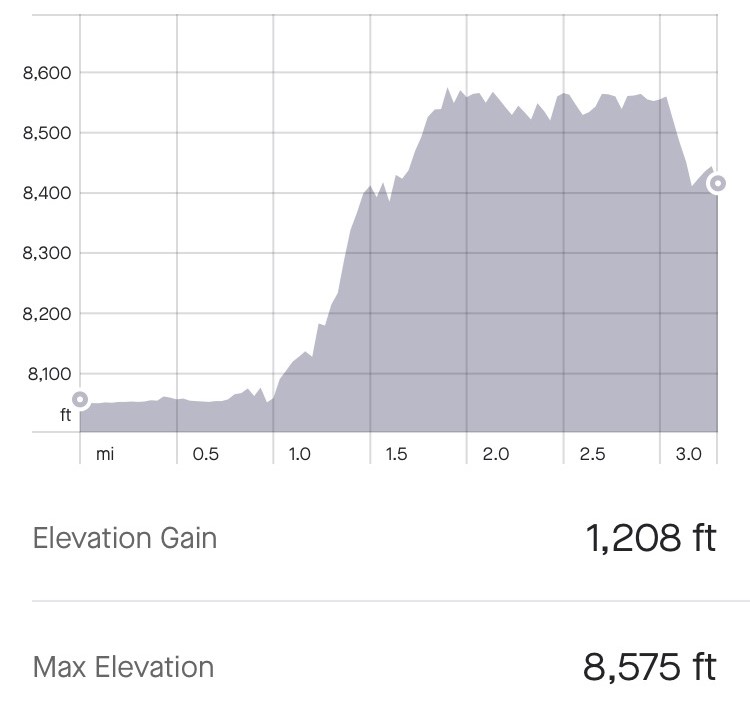
We arrived at Great Sand Dunes National Park around noon and had a picnic lunch at Medano creek not far from the main dune field parking lot beyond the visitor center. We let the kids play in the water while we plotted our route from afar. It was cool to see the little people “ants” climbing up the dunes and impressive to see how many day hikers were zigzagging to the top of High Dune (700 feet uphill in the sand!). While the weather forecast was favorable, the increasing cloud cover was discouraging.
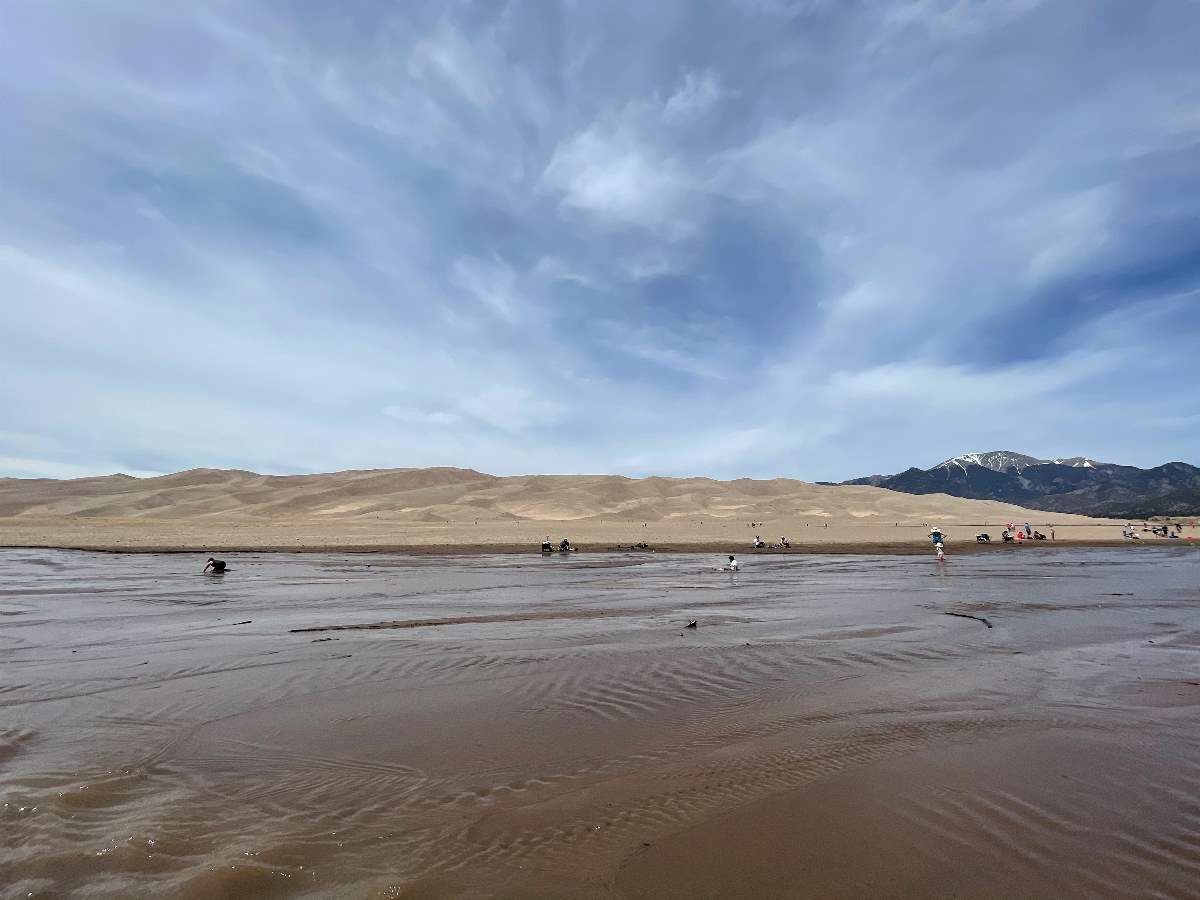
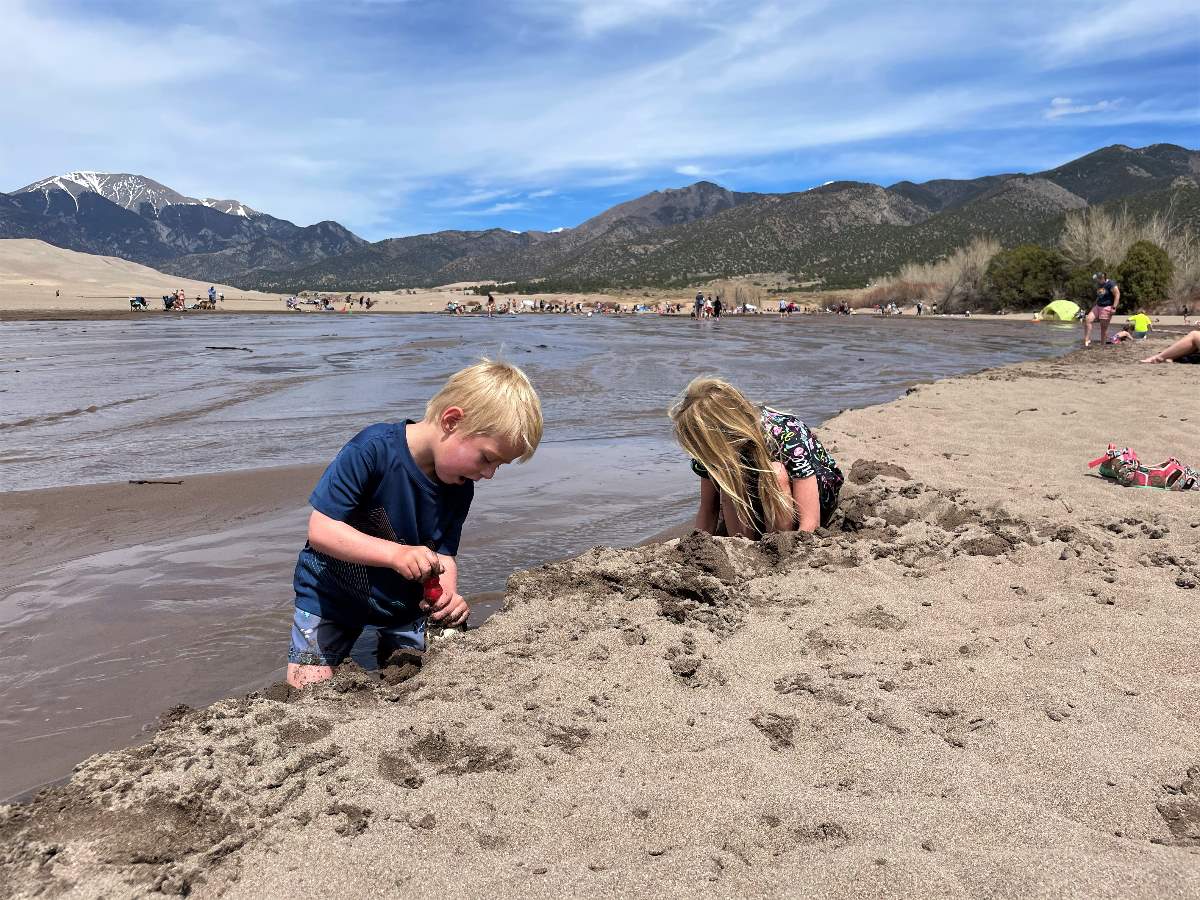
Despite the clouds, we decided it was time to dry off and start our adventure around 3:00pm. We changed the kids out of their wet clothes, grabbed our packs, and headed across the creek towards the dunes. The hike started off a bit rocky (pun intended) because the sand contained coarser pebbles and rocks here, which were continually getting stuck in the kids’ sandals.

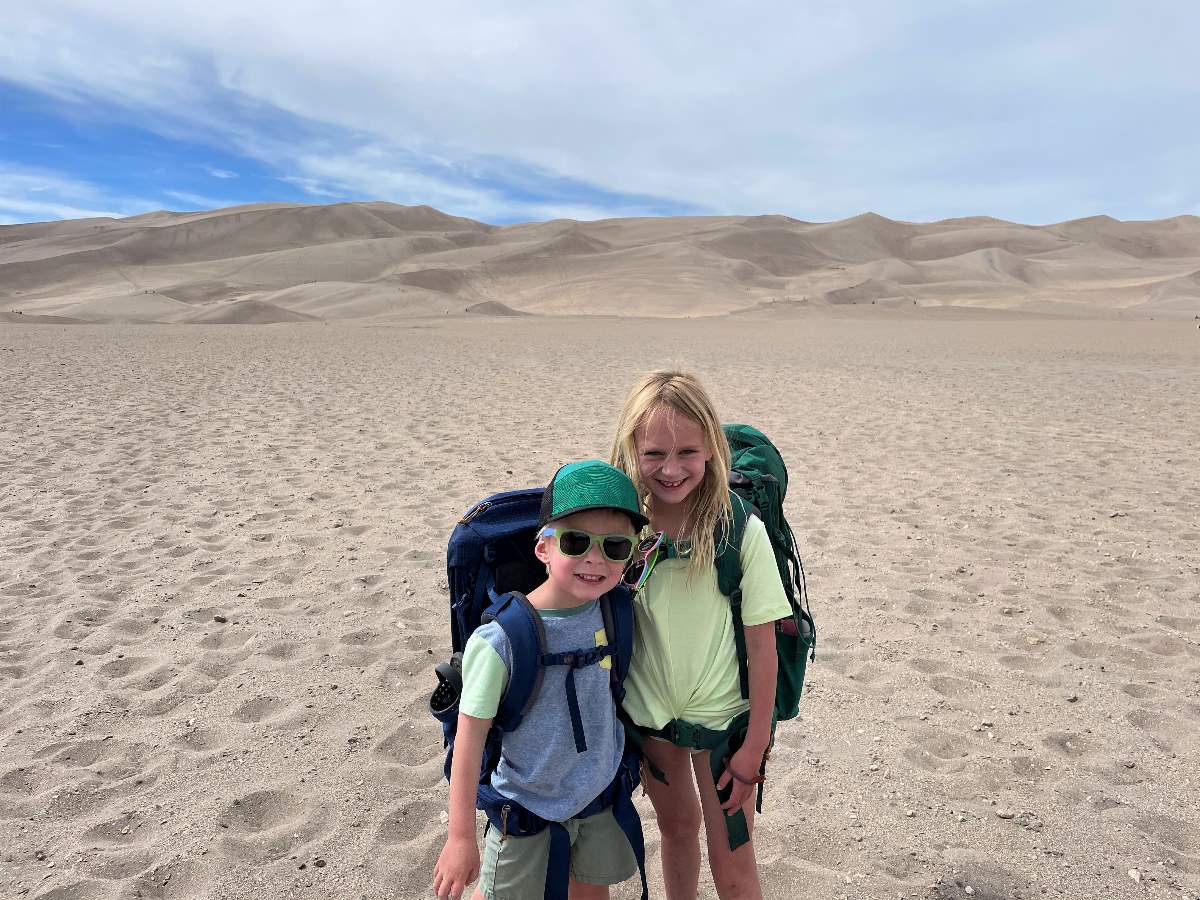
Once we got through the half-mile trek to the base of the dunes (and past the quarter-mile of coarse rocks and pebbles) and tried a few different iterations of footwear, we were all settled in and ready to climb. While I tried to psych myself in advance for how difficult it would be to hike uphill in fine sand, there is no preparing yourself for this deep sinking trek. Halfway up the dune field I was already declaring this the hardest hike I have ever done. We made it fun by counting the dunes, strategizing on the next dune to climb, and cheering on the sandboarders and sledders.

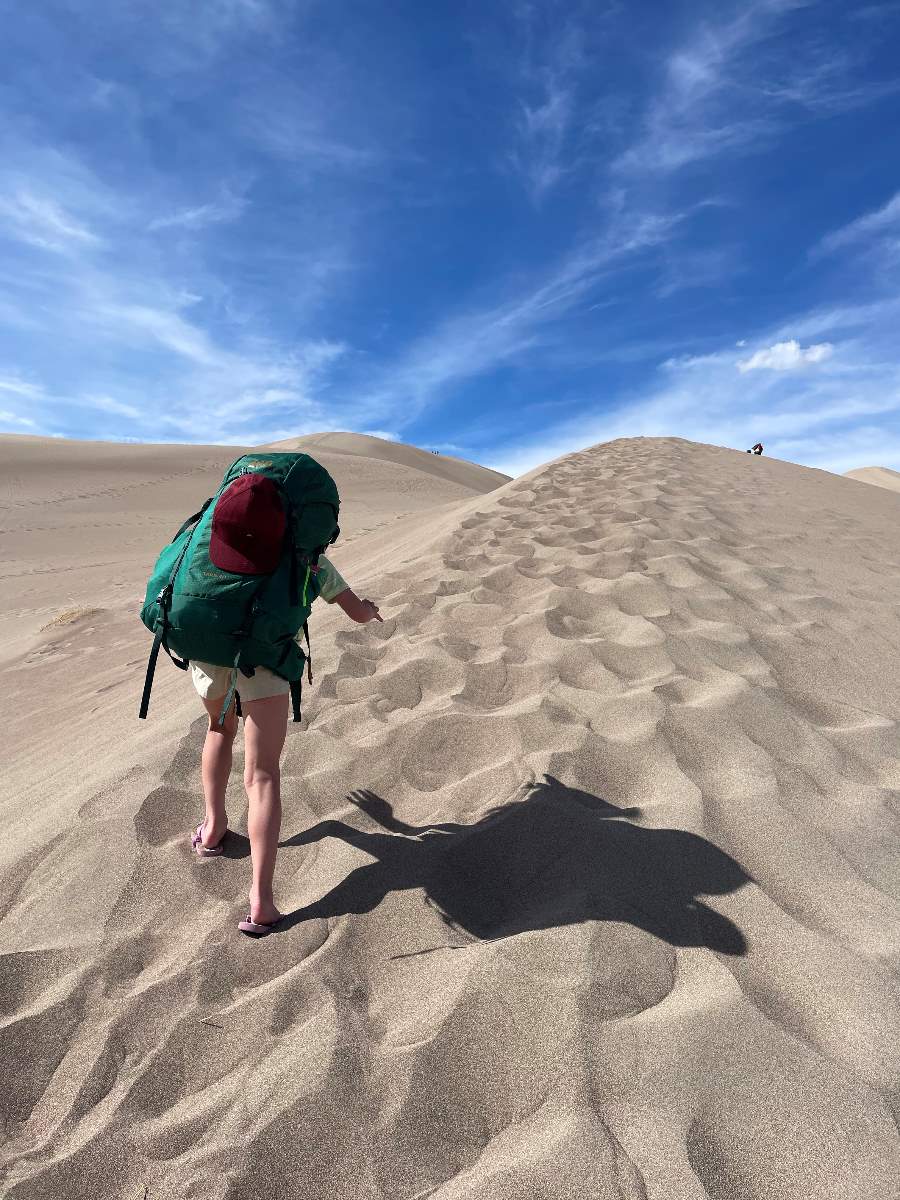
Hiking on the dunes’ ridges is a unique sensation. At times I would get twinges of fear that we were going to slide down the face of the dune, but as we climbed on, I got more comfortable knowing that the sand is so thick you wouldn’t go anywhere if you fell—which was a blessing and a curse as it was just as hard to go up as it was to go down! There are a few false summits so we were guilty of promising “we will be there when we get over that ridge.” Wishful thinking perhaps, but it kept us going.
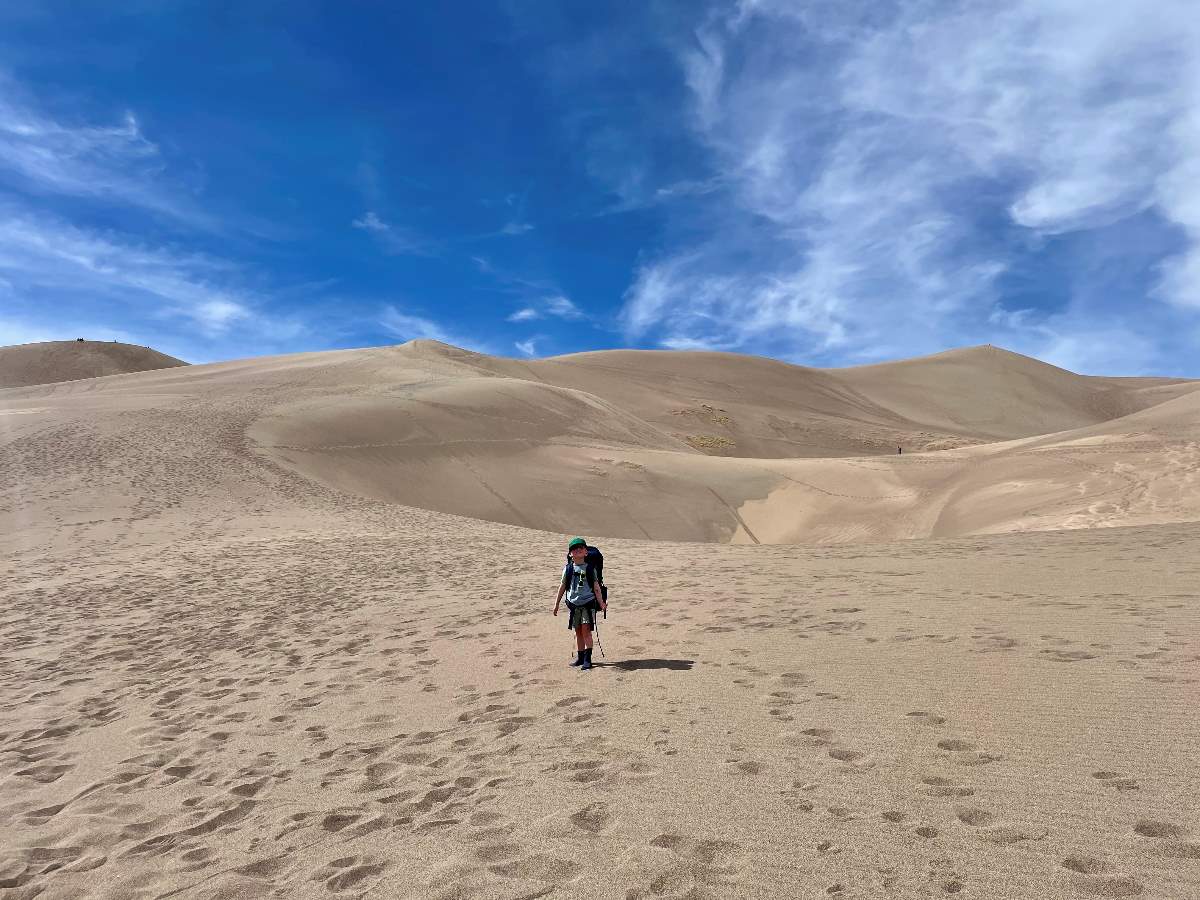
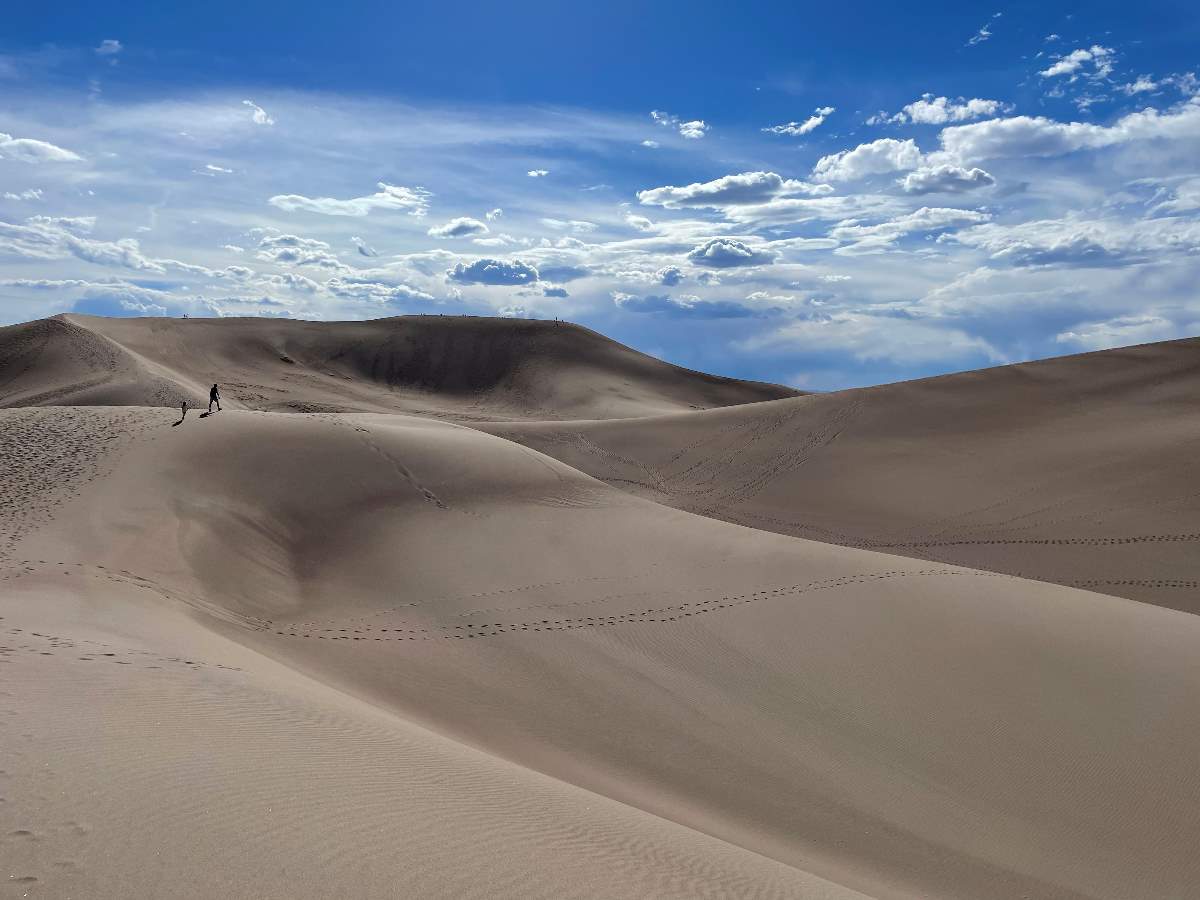
When we finally reached the top, we were rewarded with 360 degree views of the backside of the dune field, the Sangre de Cristo mountains, the distant San Juan Mountains to the west, and Blanca Peak. We dropped our packs and scouted for a camp spot. There are no designated sites so you can freely pick anywhere to camp.
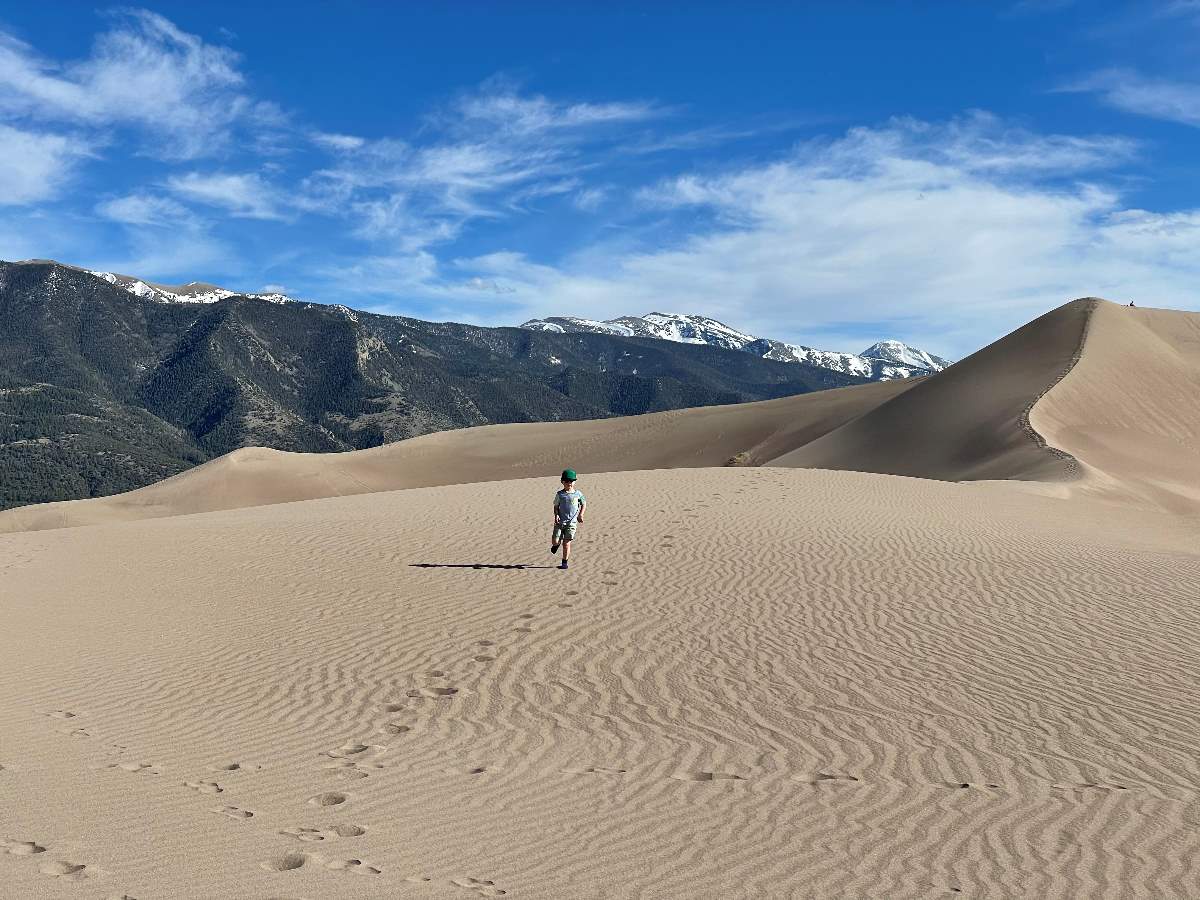

While we wanted to claim a spot right on the top of the ridge, we knew it would be too exposed if winds were to pick up—which the forecast was calling for. Instead, we spotted a good flat area just below the ridge that would block the Southwest winds, yet still had a view of the backcountry dunes and the Sangre de Cristo mountains. The beauty of the dunes having no formal trails is that instead of trekking all the way around the ridge to get to the campsite, we just slid down the side of the dune to the spot we had our eye on.


When we arrived at our “site” we proclaimed that we had the best spot in all the land, and therefore celebrated with a sandy beer!

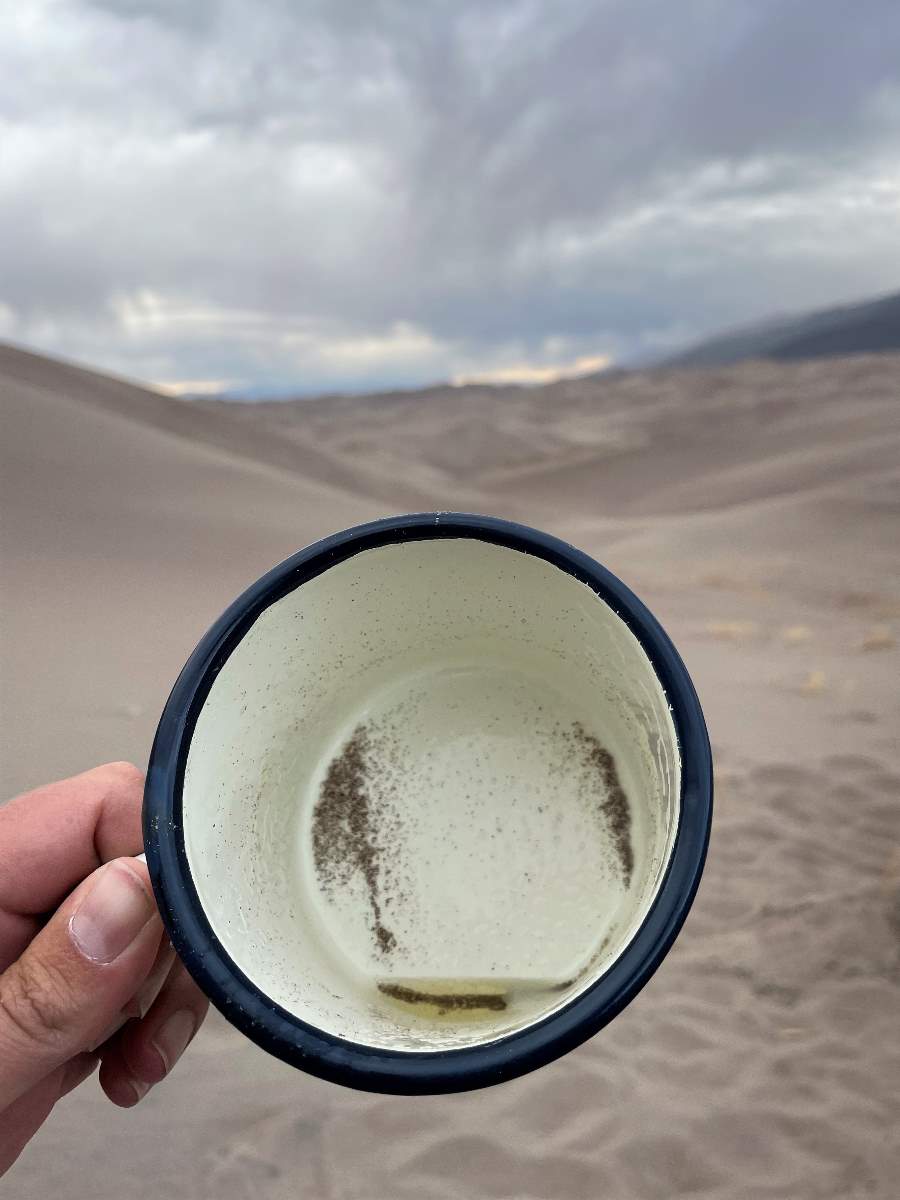
We settled in, set up the tent, and made dinner. Right after setting up the tent, the winds picked up and consequently pulled out all of the stakes we just “done such a good job” of burying.
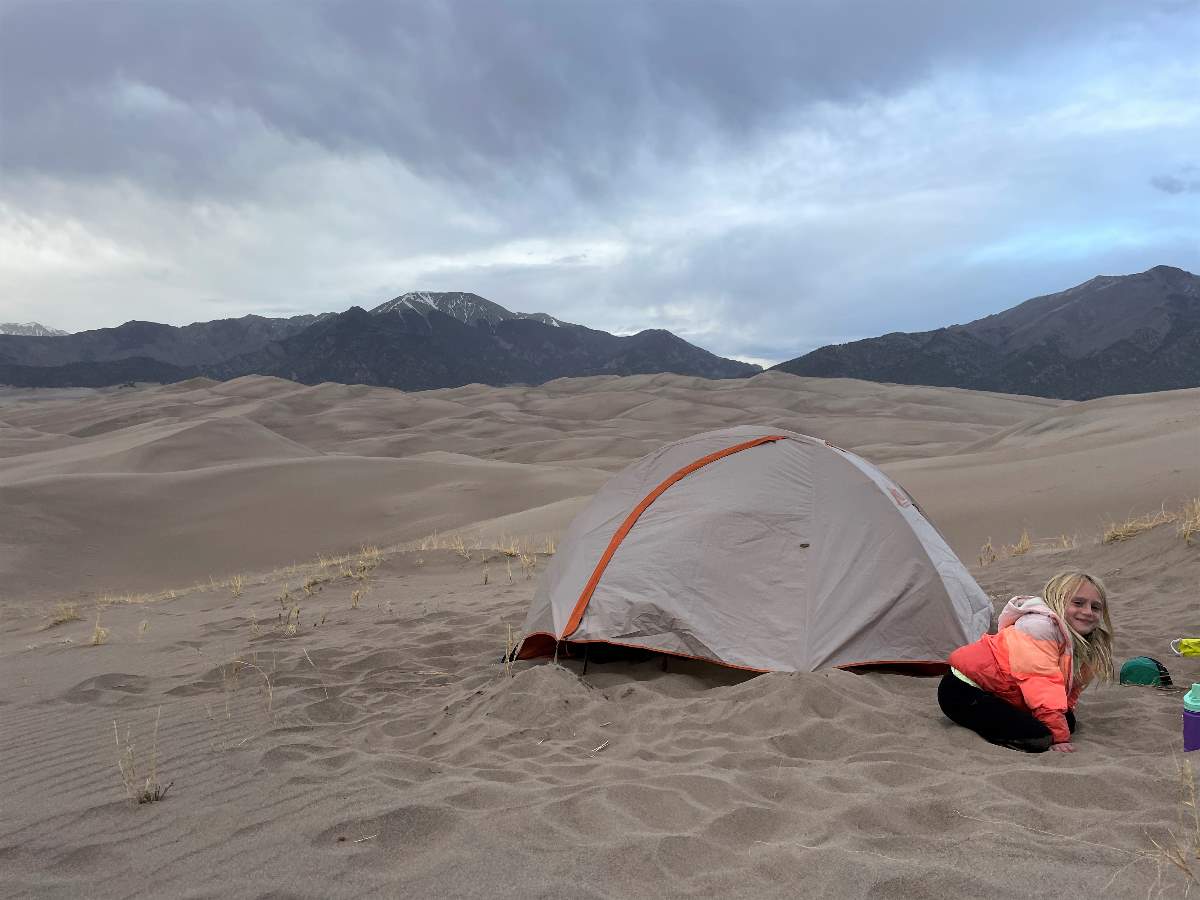
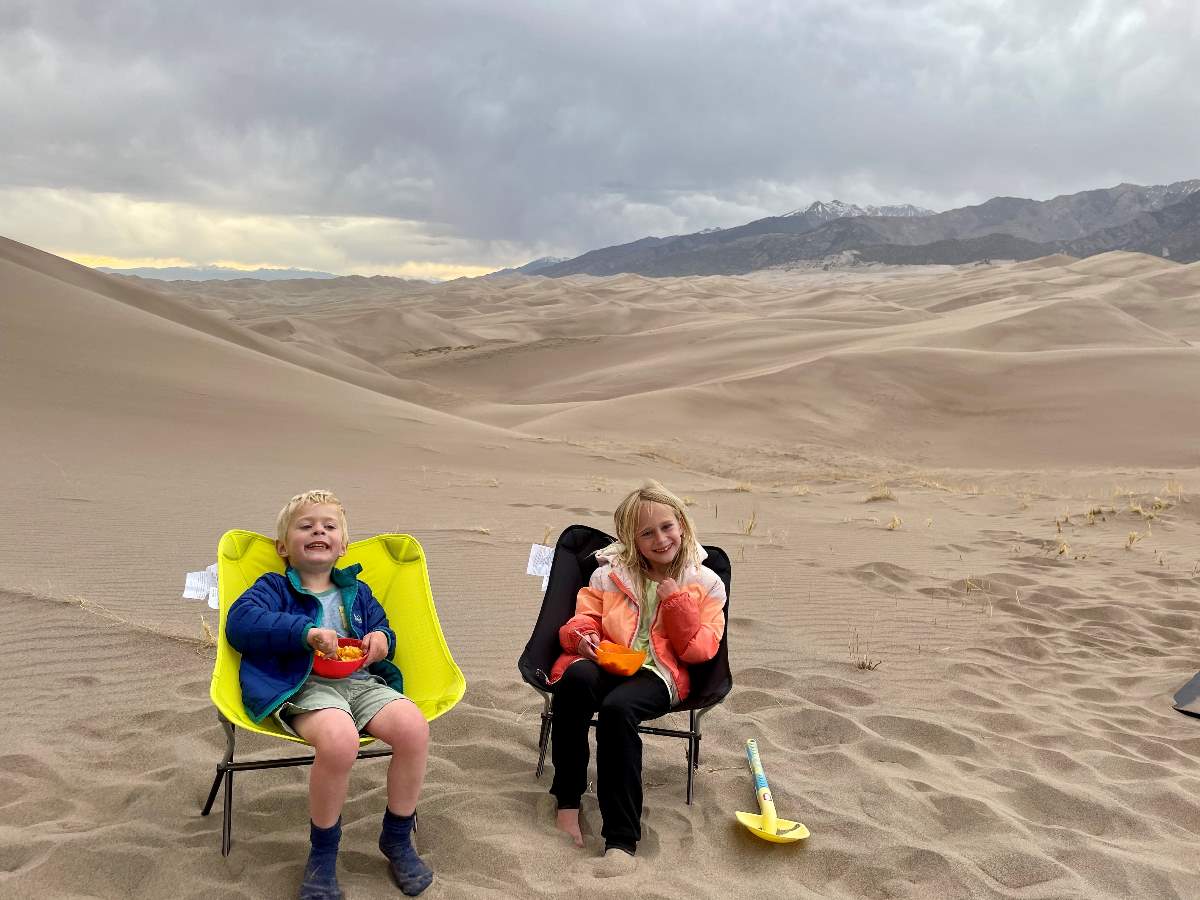
After re-staking the tent (this would not be the last time) and strategically filling the interior with our water jugs and bags to weigh it down, Bryce and Emerson climbed the ridge to see the sunset. The way the light was changing over the dunes was spectacular.
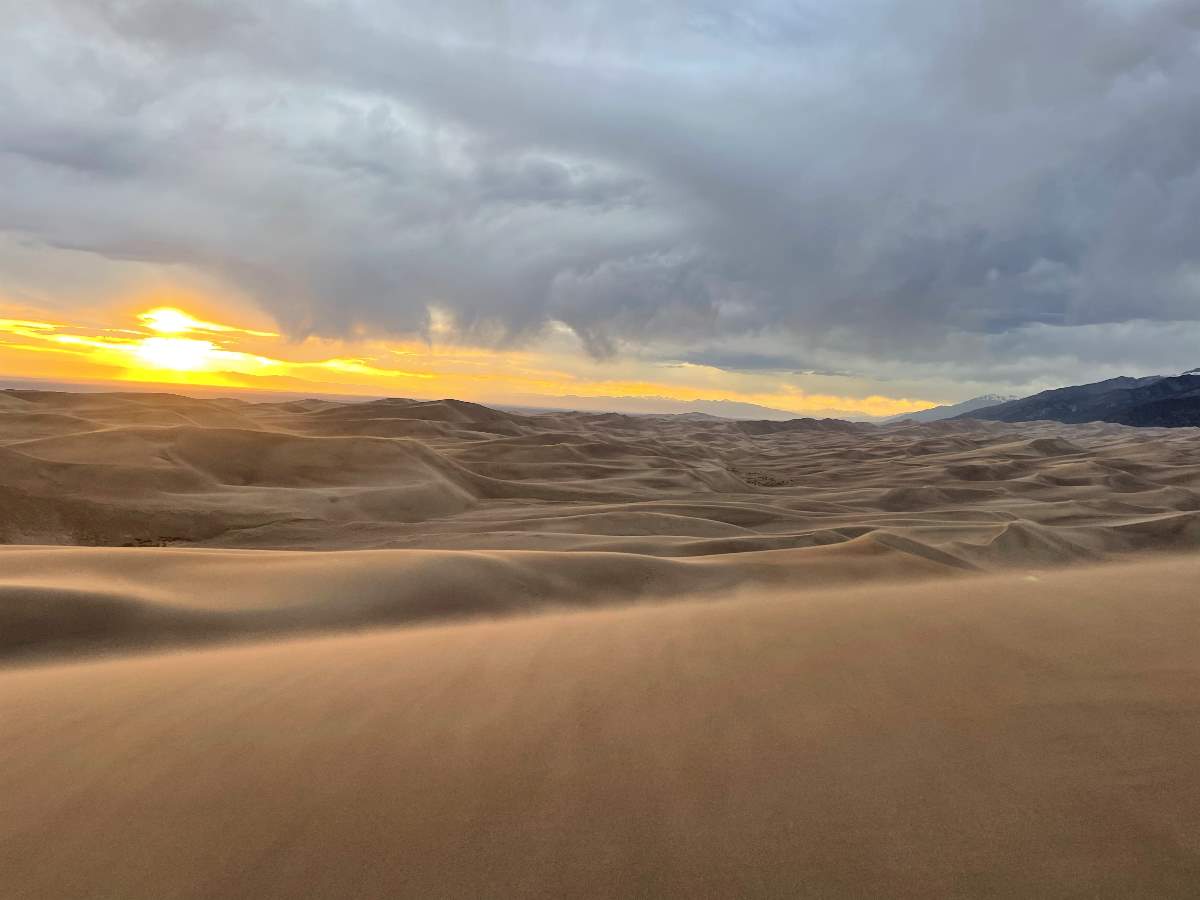
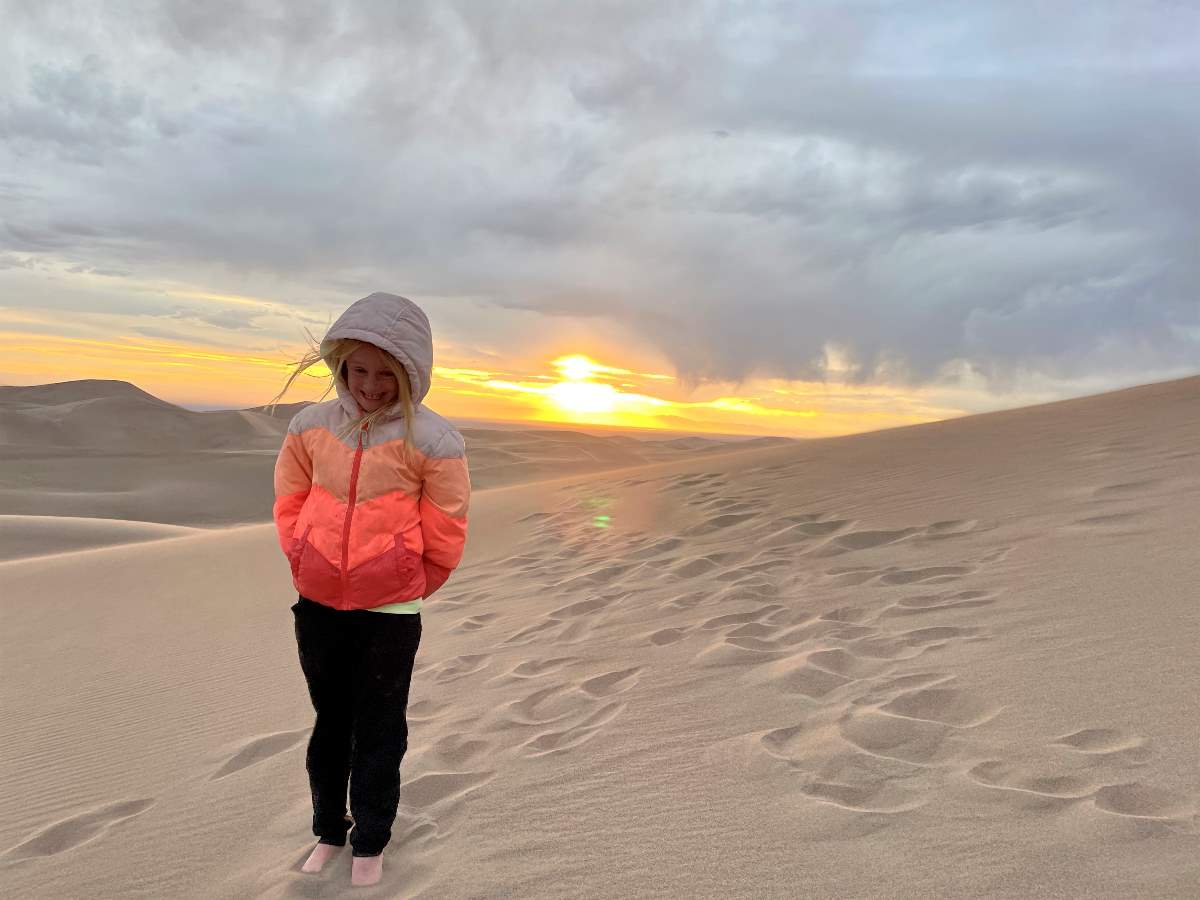
Winds picked up yet again and it felt like a tornado scene from the Wizard of Oz. I called them down as I needed help gathering our gear and holding down the fort (literally). We huddled in the tent and then looked out to see that the sunset had transformed the sky into magnificent purple and fiery red hues.

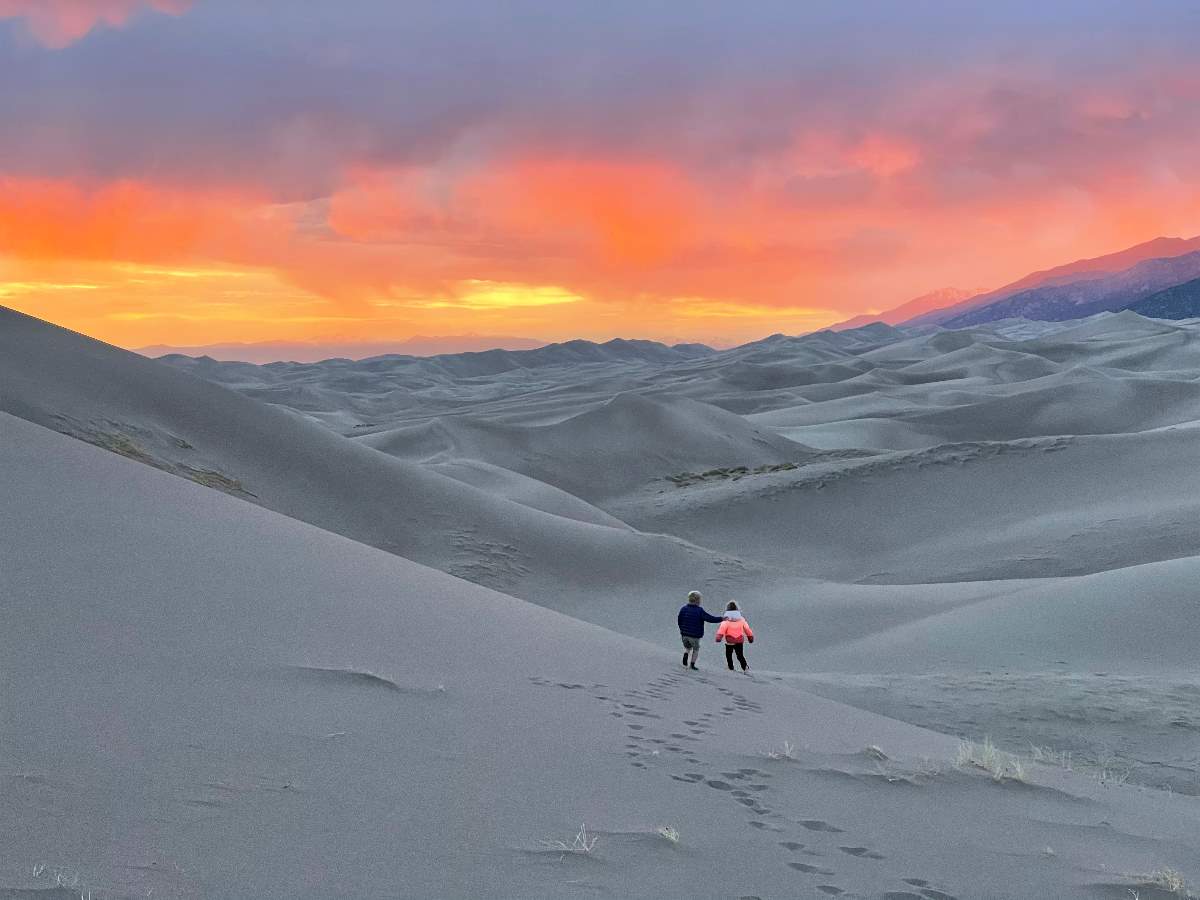
The winds died down long enough for us to frolic in the sunset, have some hot chocolate and take in the majestic beauty. We were all on a high! Later when recounting the highs and lows of the trip, it was funny to realize that a high and a low could be so closely compressed into one specific hour of camp time—everyone’s high was the sunset and the low was the wind.
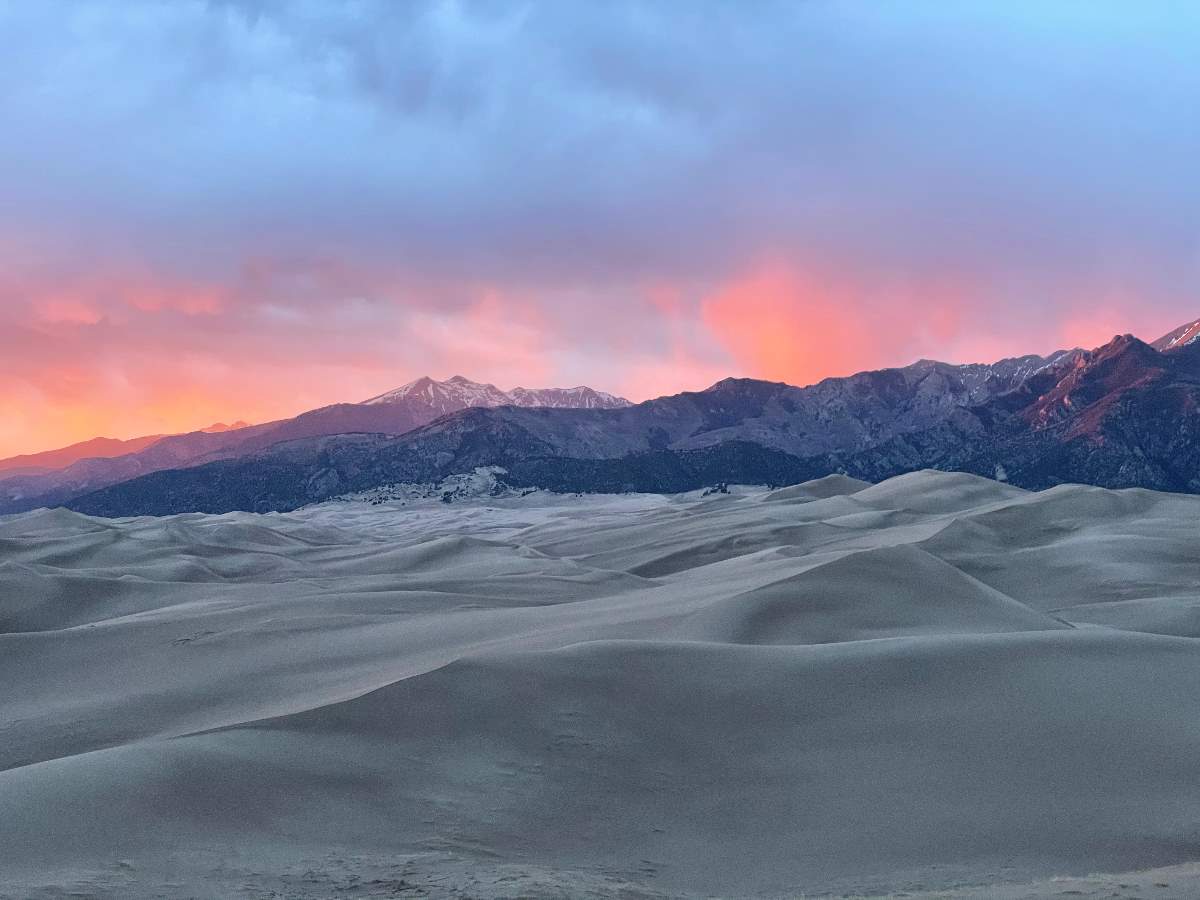

After the sunset, we headed into the tent for bed, but not without setting up our glamping ambience of string lights. As we settled in, the wind stopped for the night and we had a calm, peaceful evening. The kids slept the entire night without waking. As a parent bringing kids to the backcountry for the first time, I would say that was the biggest success!
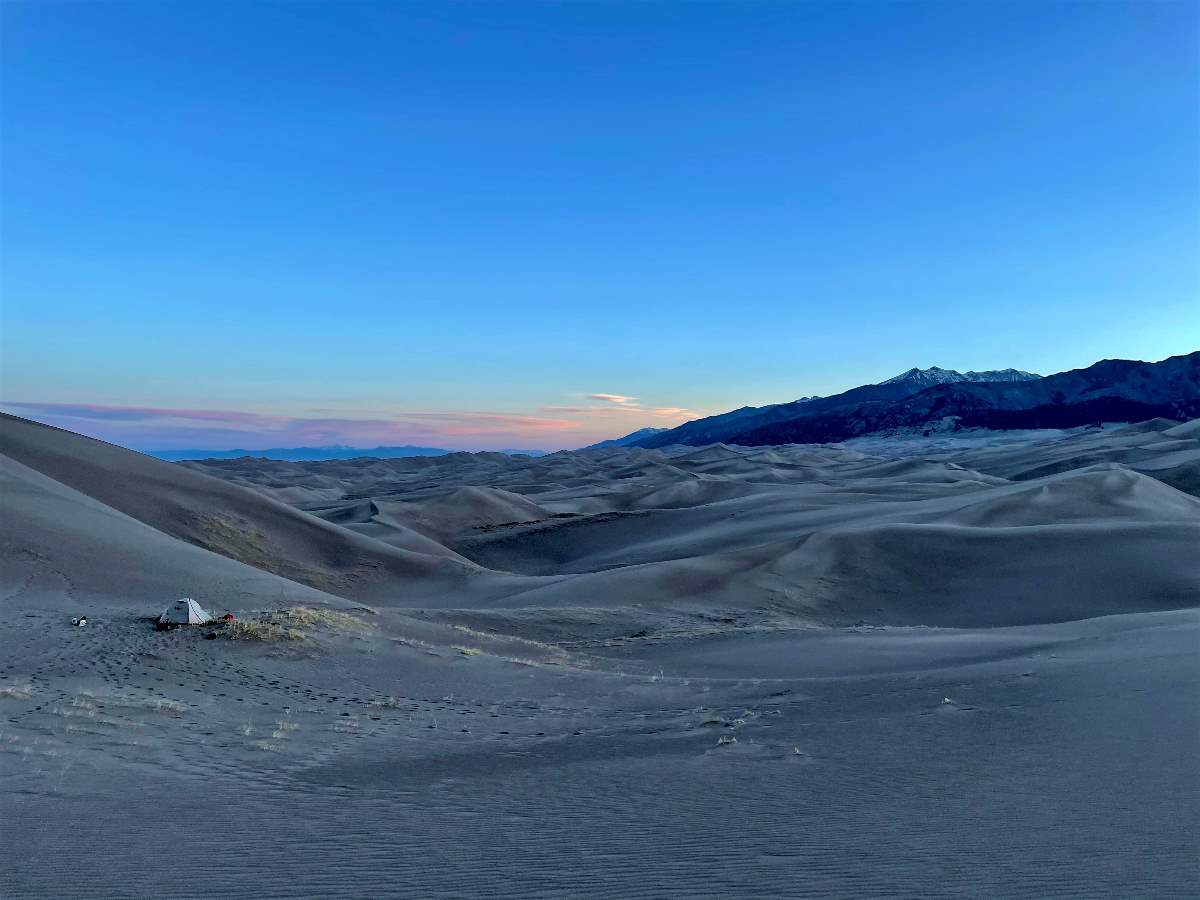
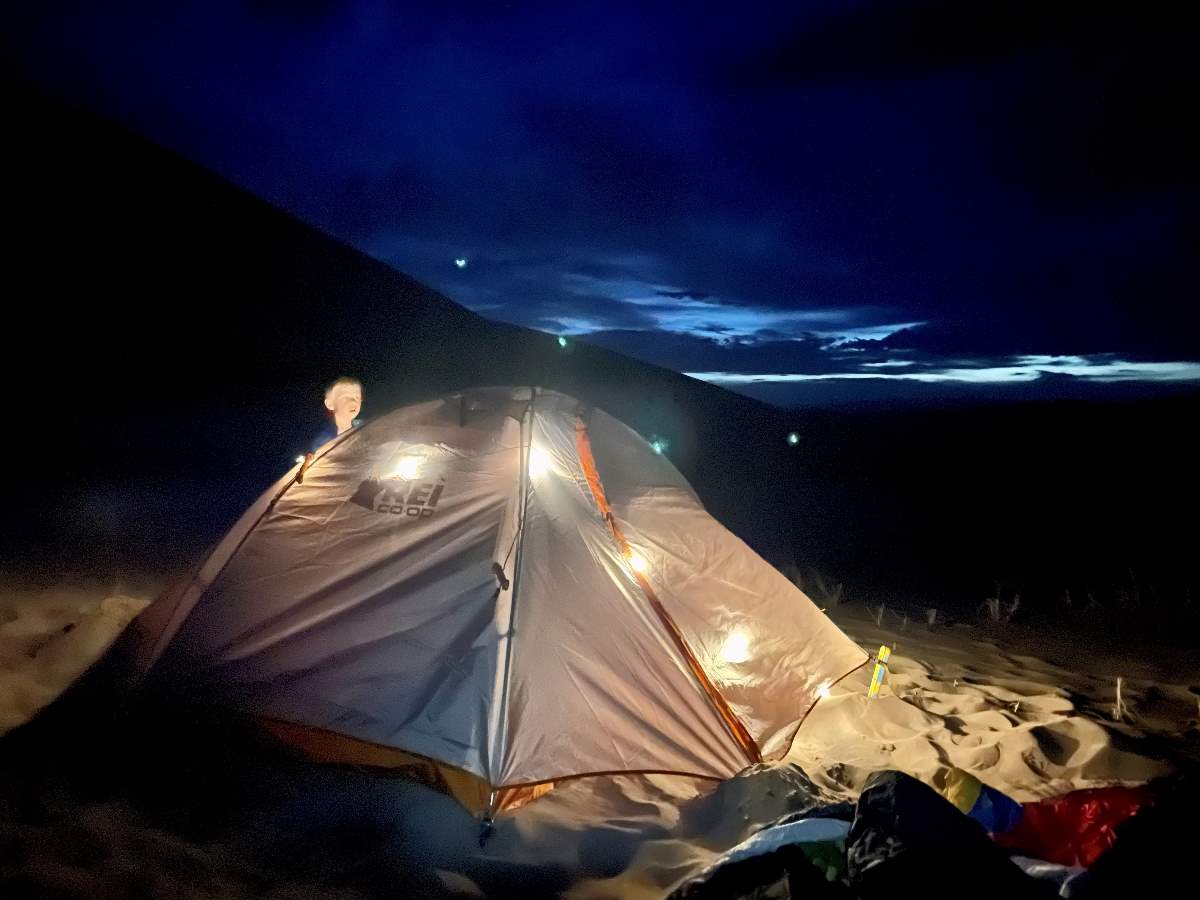
Bryce slept in a bivy sack beside our two-person tent, so at the first sign of dawn he was awakened by the bright sun. That was lucky for us because he was able to climb up to the ridge for some epic morning light. Can you spot our tent below in this first shot?
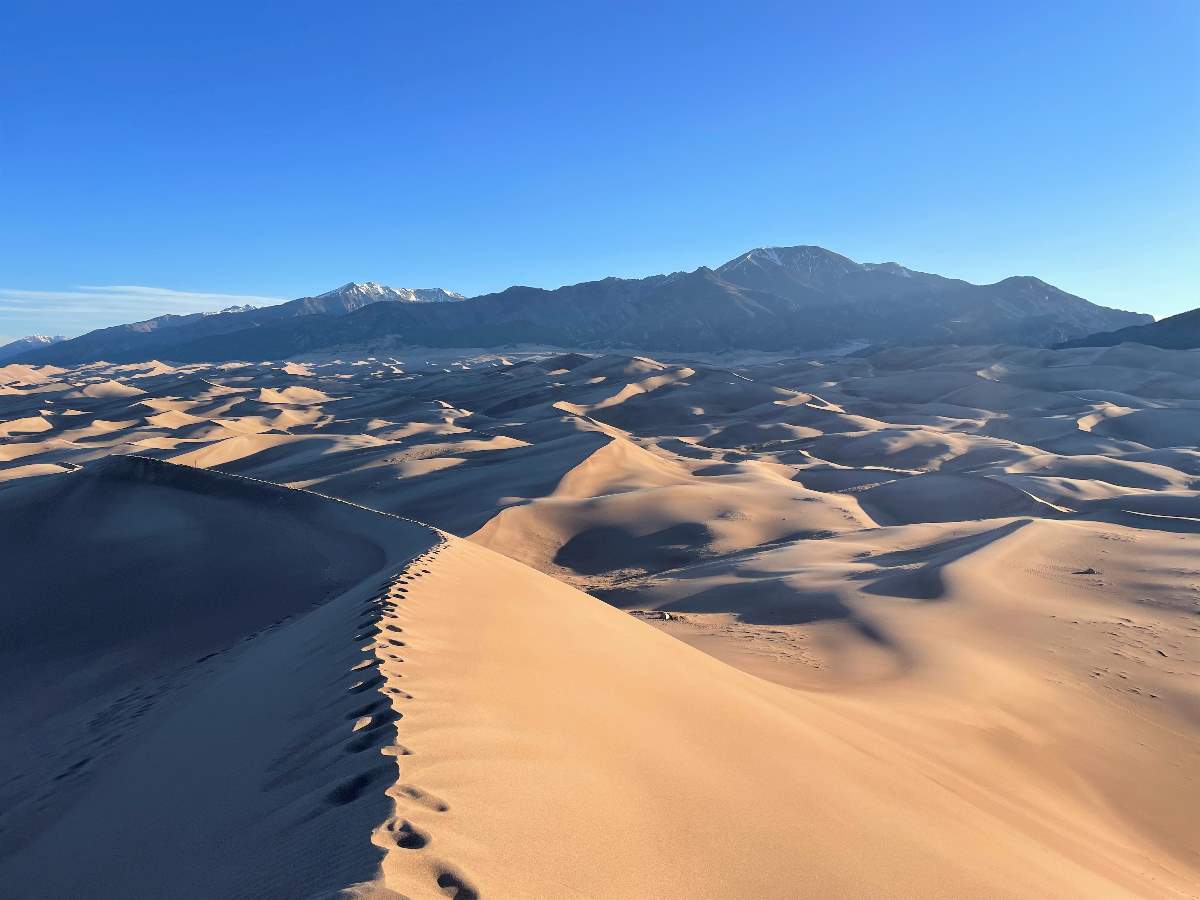

We ate our oatmeal breakfast and drank sandy coffee, then played a bit in the sand. They could have played for hours if they weren’t tempted by the creek below. The only thing better than sand is sand plus water. Despite our warning to conserve energy for the hike back, the kids spent their morning climbing up and down the 100 foot dune ridge.
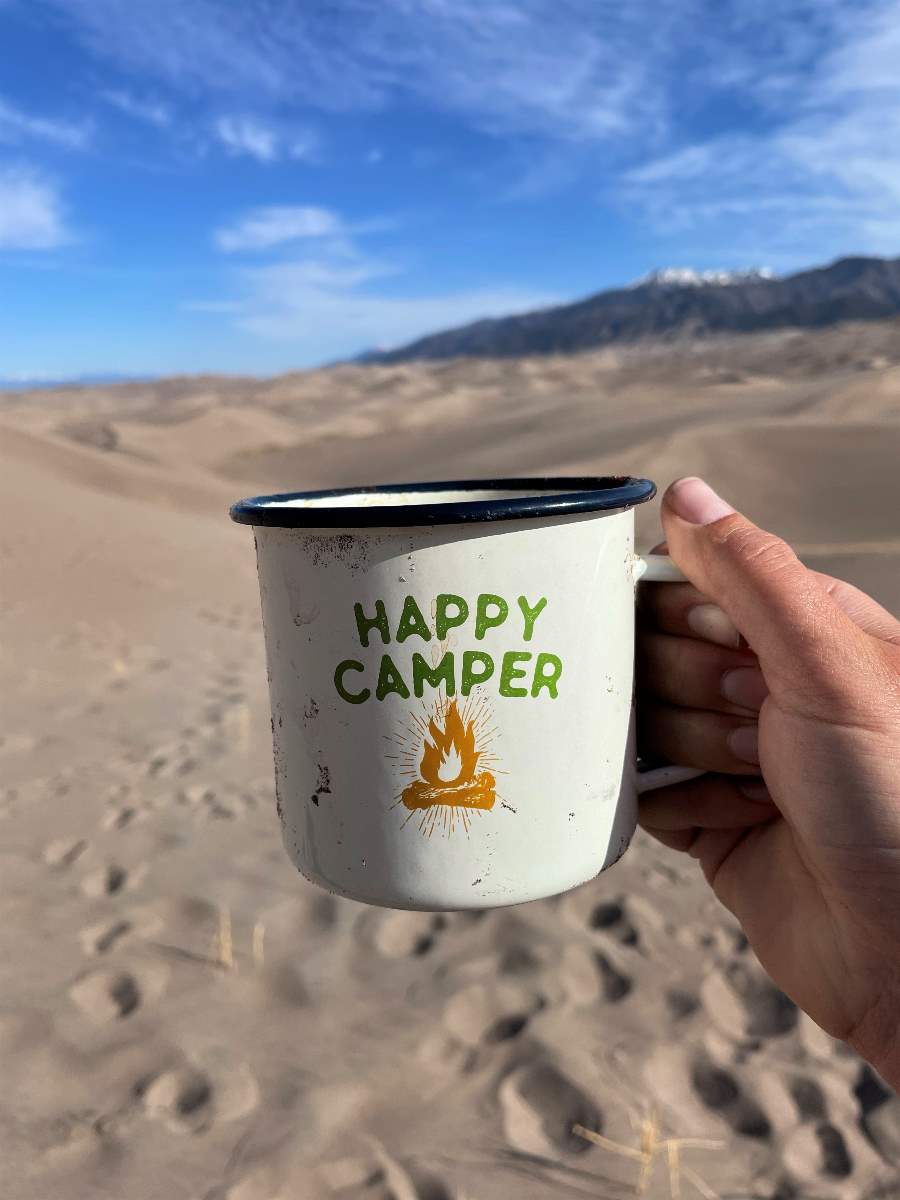

Our hike back was beautiful! The sky was bluer, our packs were 3 gallons of water and several beers lighter, and the route was mostly downhill!

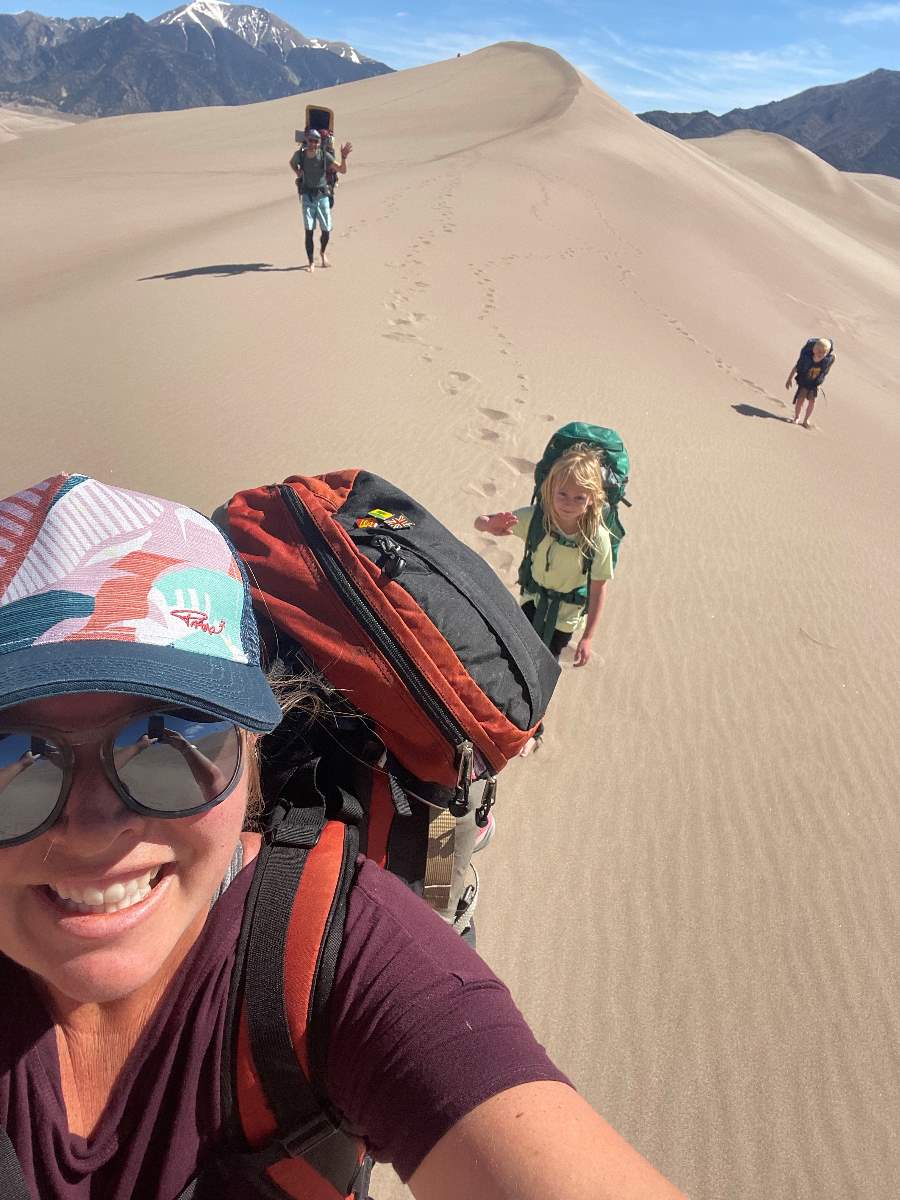
We rented a sand sled on our way into the park and had a blast sledding down the dunes on our hike back. Honestly, the kids were just as happy sliding on their bottoms, but it made for a fun addition to the trip.
We finished our day by playing in the creek. My feet were very happy to soak in the gently flowing water. The kids were happy to build sandcastles and dams.
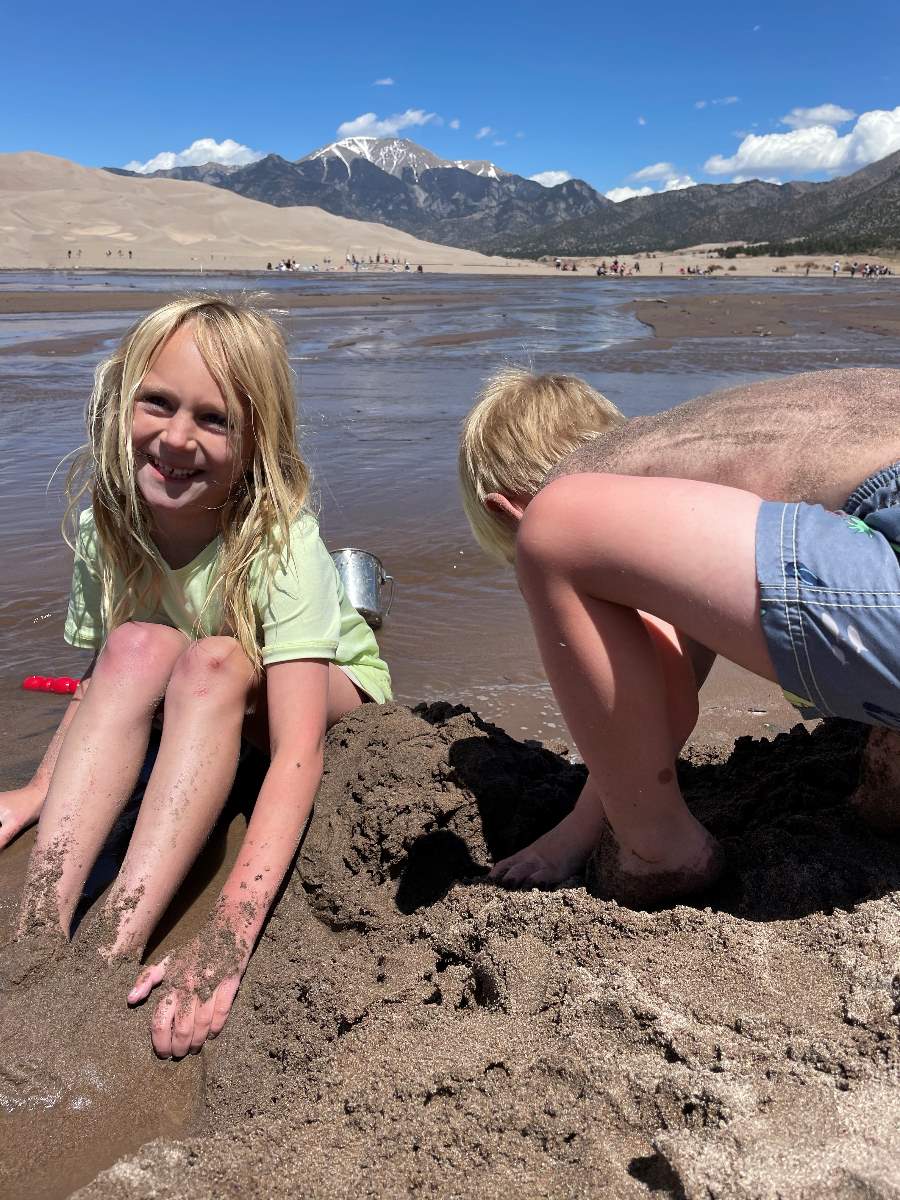

On our way out of the park, we hopped out to snap an obligatory photo of the kids at the National Park sign, which happens to have an epic view looking back at the park. “Biggest smile gets the biggest ice cream!” If you make this same bribe, you can follow through on your promise with ice cream bars at Oasis right beyond the sign. We also ate lunch and returned our sand board rental there!
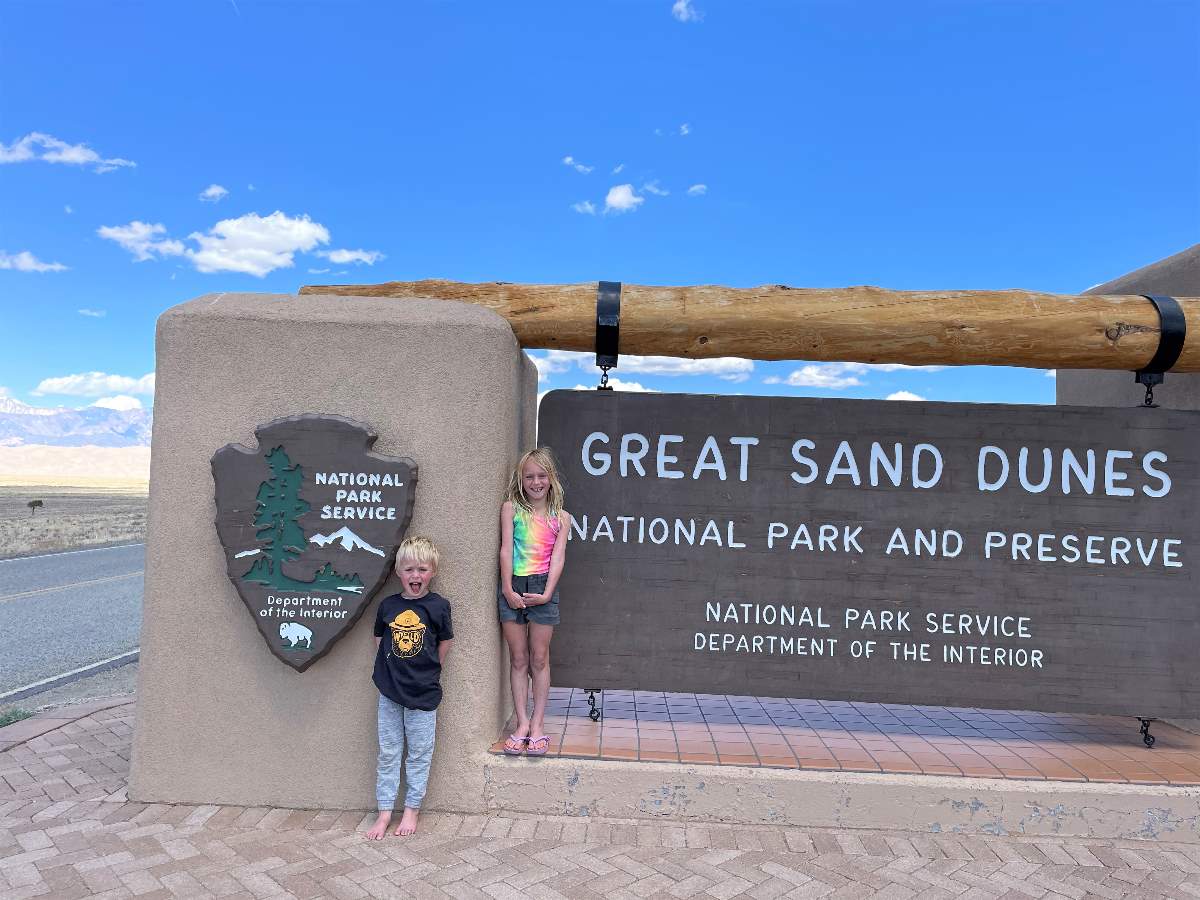
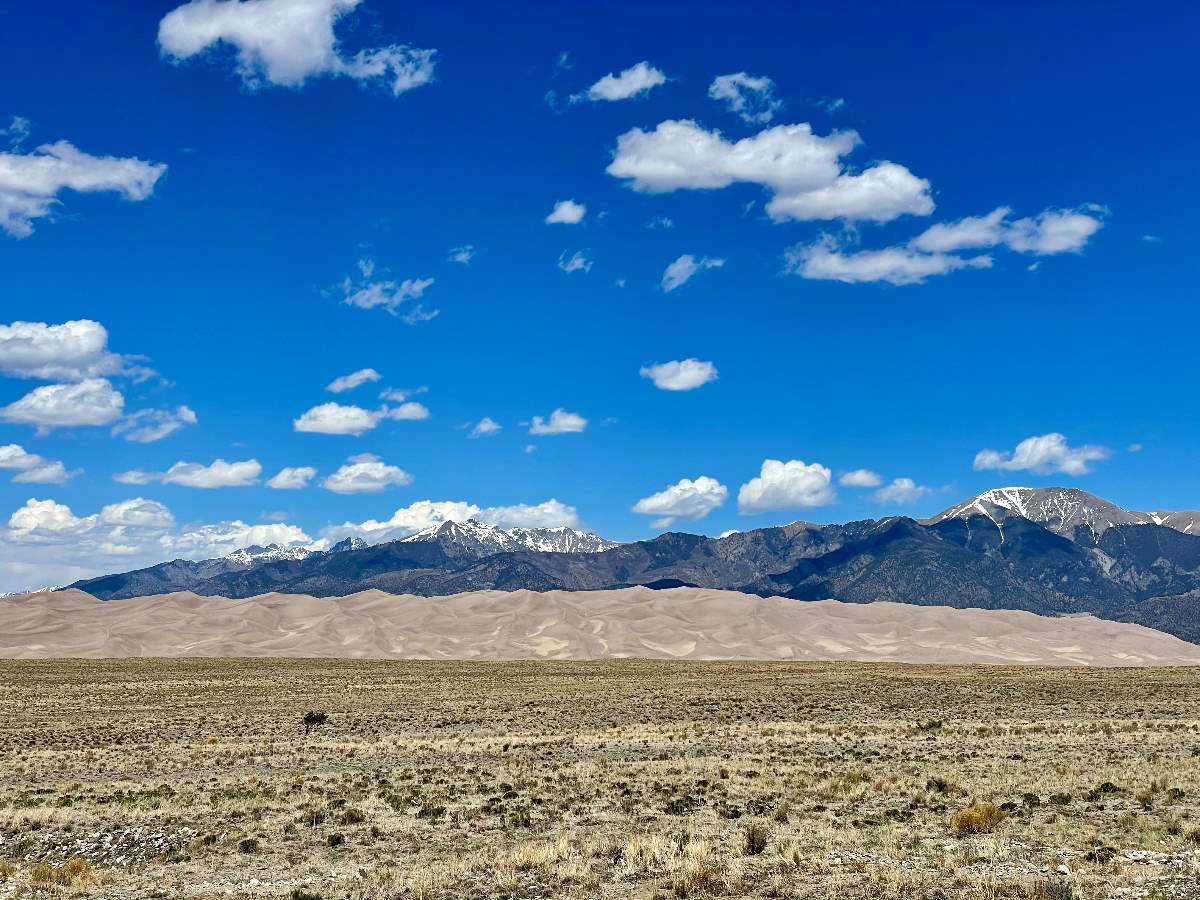
10 TIPS FOR BACKPACKING GREAT SAND DUNES NATIONAL PARK
1) RESERVE A BACKCOUNTRY PERMIT BEFORE BACKPACKING GREAT SAND DUNES
In order to camp in the backcountry, you must reserve a backcountry permit in advance through reservation.gov. Permits can be reserved 3 months in advance and are available year round on a rolling basis. Be sure to print your permit in advance so that you can display it in your car. Otherwise, overnight parking is not allowed in the Dunes Parking lot.
2) WHEN TO GO – SEASON AND TIME OF DAY
Late spring or early summer (May and June) are the ideal seasons for backpacking the dunes. It’s not yet too hot, but warm enough for pleasant daytime temperatures. We visited on the first weekend of May and were worried that it would be cold in the night, but we were fortunate that the temperatures were mild. Find more information here on typical weather conditions and a what to expect at the dunes in each season. Because the dunes are exposed with no shade or shelter, it is not recommended to start your hike to your backcountry camp until late afternoon. This is unique as most backpacking trips we would start early in the morning in order to get to camp and set up early. In this case, it’s better to hike as it’s starting to cool down and then leave early in the morning to head back. There really isn’t a point in getting out to middle of nowhere in the dunes to spend time in the heat exposed. See below for some fun ideas about how to spend your time in the day at the dunes before heading to your backcountry site.
3) WHAT TO PACK WHEN BACKPACKING GREAT SAND DUNES
We were very fortunate that we brought everything we needed and didn’t feel that we overpacked. Our kids (4 years old and 6 years old) both carried their own backpacking pack (the REI Tarn 40) with a sleeping bag in it. Our youngest’s pack was around 6 pounds after it was packed. Our 6-year-old also carried her own clothes. Her pack was around 8 pounds. My pack (REI discontinued pack from 19 years ago that still does the trick!) was about 35 pounds and Bryce’s was close to 70! He definitely took one for the team! While the kids did great on the way up, we exhausted parents somehow got stuck with all of the gear towards the end while the kids played and slid their way down!
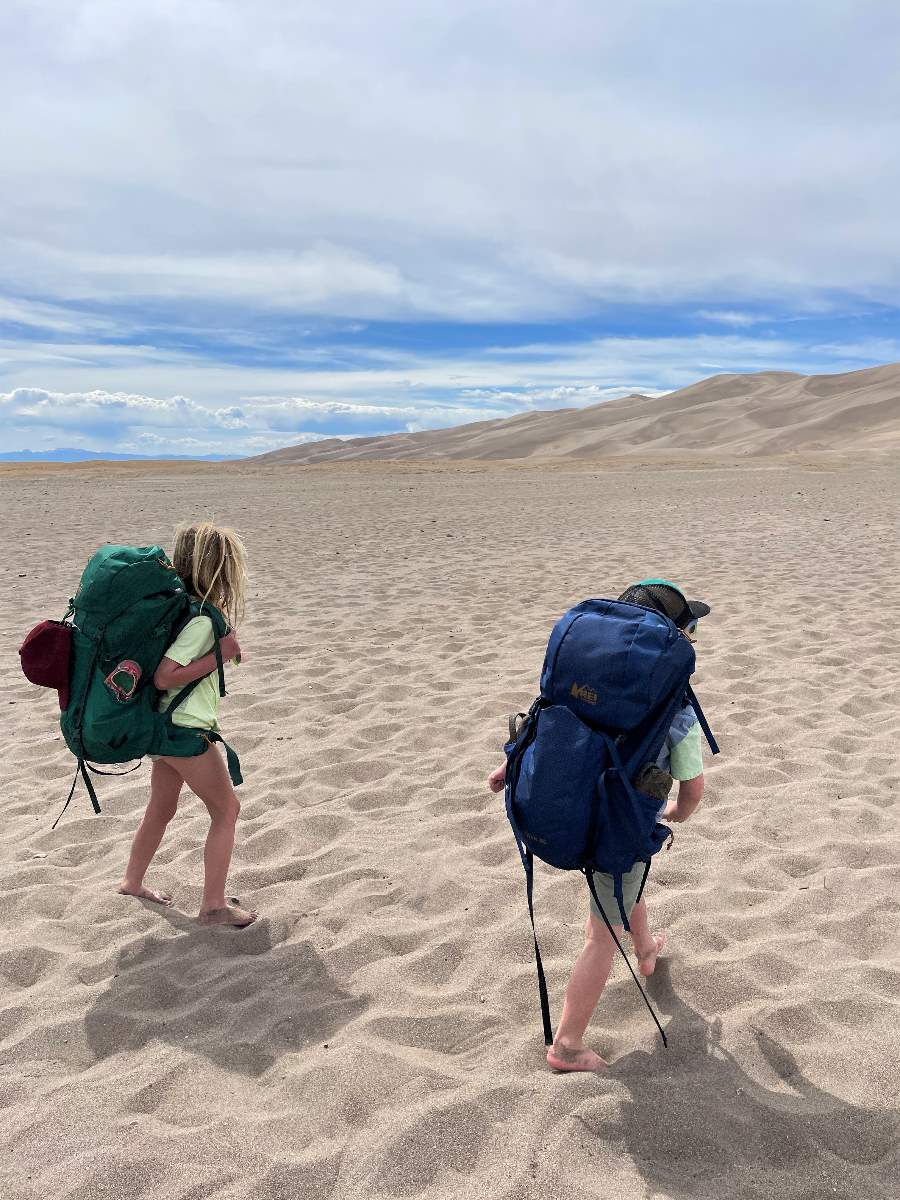

Below is a rough outline of what we packed when backpacking Great Sand Dunes, broken out in each of the essential categories:
what to pack – Sleep
We brought a light weight 2 person backpacking tent for me and the kids and a bivy shell sack for Bryce. This was a lighter set up than our REI 4 person frontcountry tent. We each had a lightweight compression sack sleeping bag and a blow-up sleeping pad.
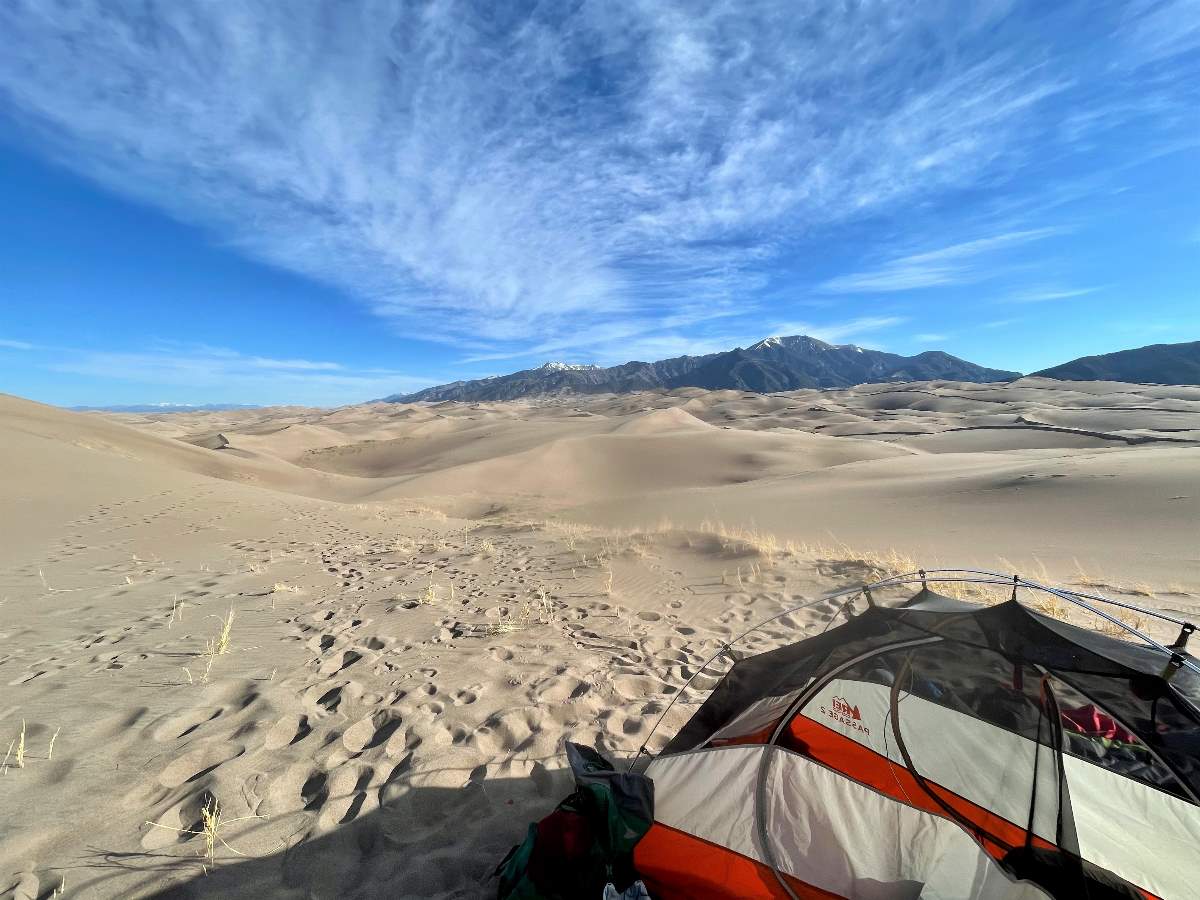
what to pack – Eat
For food, we packed Mountain House lasagna for mom and dad and Mountain House mac and cheese for the kids. For breakfast, we packed protein packed oatmeal. We ate a picnic PB & J lunch by the creek prior to heading up the dunes so we didn’t need to worry about packing lunch. For the hike, we brought our typical day hike snacks. To prepare and serve the food we brought the Jet Boil, lightweight bowls and utensils (nothing fancy here—we just use plastic kid bowls from the toddler stage and Menchie’s plastic spoons!), lightweight tin cups for hot cocoa and adult beverage of choice, and water bottles. We also brought a little container filled with Dr. Bronner’s soap for washing hands and dishes.
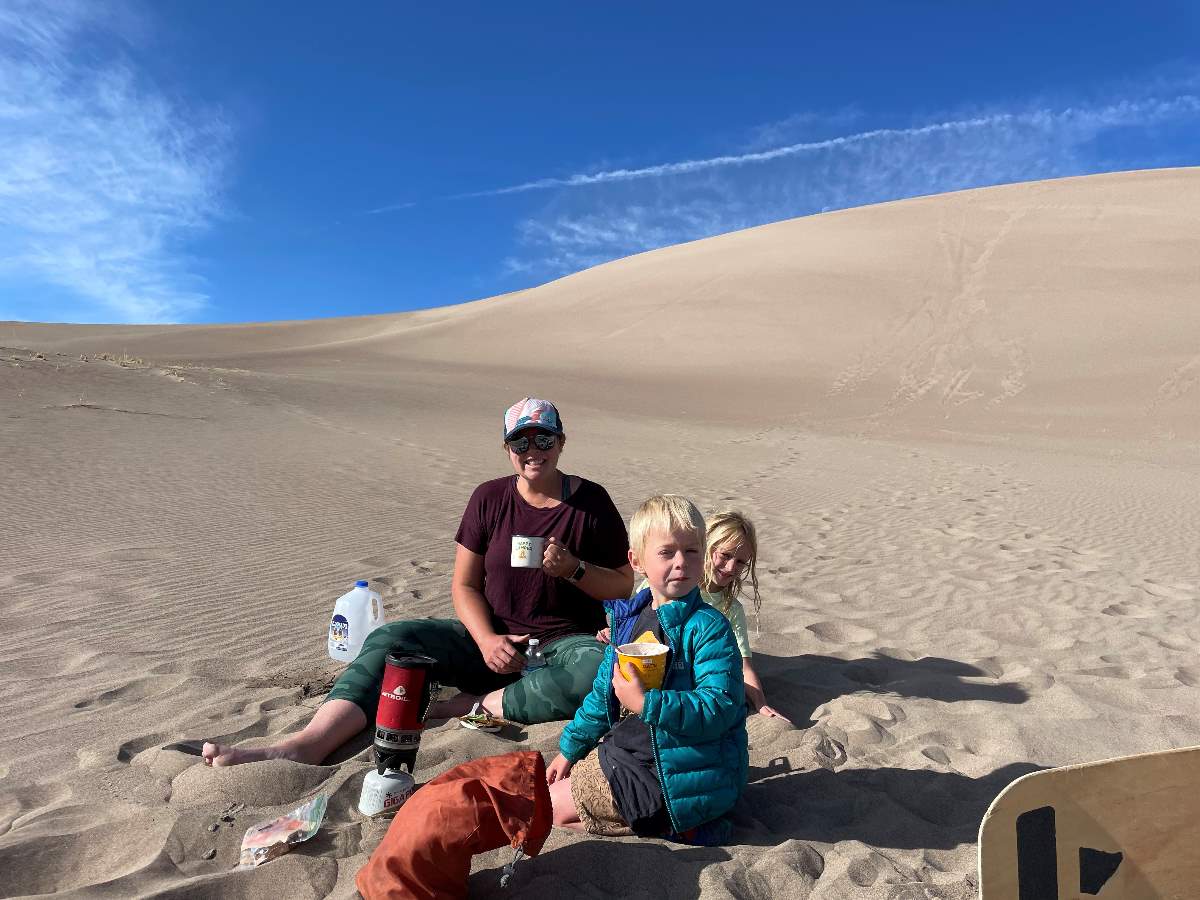
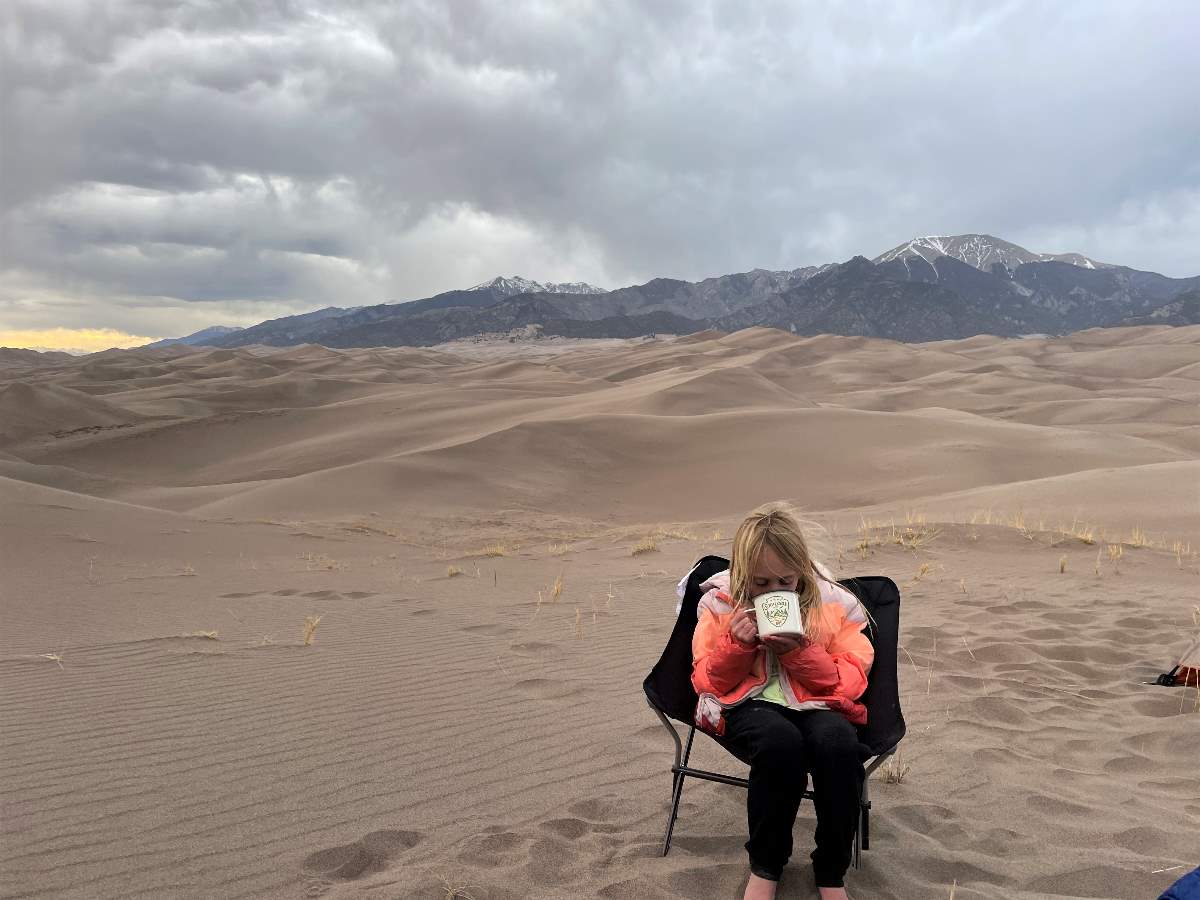
what to pack – Comfort
We didn’t end up needing the warm clothes (long underwear, hats, gloves, and extra socks) that we packed for the evening, but it is always better to have warm gear that goes unused as opposed to needing warm gear and not have it. ALWAYS! They did wear their jackets due to the wind and the cooler morning temperatures. Sun hats, sunscreen, chapstick, and sunglasses were a must-have in this exposed terrain.
what to pack – Safety
Some safety items that we always have with us are a map, headlamp, compass, First Aid & emergency kit (with a whistle, fire starter, poncho, etc), pocketknife, water purification tablets, hand sanitizer, and extra water.
what to pack – Other
Solar phone charger, string lights for camp ambience that also double as an extra charger, and our brand new Big Agnes ultralight camp chairs, shovel for sand play and to practice Leave No Trace when using the “backcountry bathroom”, and a sand sled.
4) WEAR THE APPROPRIATE SHOES
This terrain is unique to even the most experienced hikers. We wore a variety of footwear across our family—I wore my Chacos, Bryce wore his tennis shoes with socks, Walker wore only socks with no shoes, and Emerson alternated between bare feet, flip flops, and Keen sandals. I do NOT recommend hiking this barefoot unless you are hiking in the evening or in the morning due to the sand temps (the sand can get to be 150 degrees!). Luckily, the temps did not get extreme for our trip, so we were okay to be barefoot. My recommendation would be tennis shoes as Bryce seemed to have it the best, although he did get a lot of sand in his shoes that he needed to empty out periodically. My Chacos were a good idea as I could kick the sand out easily, but the sand did a number on the bottom of my feet and by the end of day two I was hurting and wishing I had real shoes on. The sand on the dunes is very fine and soft, but the trek from the creek to the dune field is rocky and can be brutal on sensitive feet.
5) HOW TO STAKE DOWN YOUR TENT IN SAND WHEN BACKPACKING GREAT SAND DUNES
This is one where you can learn from our mistake. We mistakenly brought regular tent stakes like rookies and our entire tent flew up right after we pitched and staked it. The slick tent stakes don’t hold in the fine sand, especially with wind (which is likely a given). I would recommend snow stakes instead of traditional tent stakes as they are longer and have a larger surface area and therefore have a better grip in sand.
6) CHECK THE WEATHER – AND EXPECT WIND!
Regularly check the pinpoint weather forecasts (here’s the one for the dune fields) leading up to your trip. As with all Colorado hikes, thunder and lightning storms are a threat and you should avoid hiking or backcountry camping if they are in the forecast. The sand dunes were formed by wind blowing sands from the San Juan Mountains to the Sangre de Cristo Mountains through the San Luis Valley, so strong winds should be expected. Hence, the importance of those snow stakes for your tent! In strong wind storms, the sand can be painful if it pelts your skin (luckily we didn’t experience this), but you may want to consider pants, long sleeves, and a face buff for this reason.
7) ACCLIMATE TO THE ELEVATION
The dune field elevation starts at around 8,200 feet so if you are traveling from lower elevation, you will want to acclimate prior to strenuous activity. The best way to avoid altitude related sickness is to drink LOTS of water before and during your trip.
8) BRING MORE WATER THAN YOU WANT TO CARRY
Since there is no water source in the dune field, you need to carry all of your water on your back. Because this is a challenging hike, in the heat with no shade, and at elevation—that means a LOT of water! A good rule of thumb is to have 1 liter of water per person for every hour when hiking in the heat and at elevation. For a trip like this, we brought 1 gallon of water per person for 24 hours. That’s heavy, so be prepared!
9) CHOOSE YOUR ROUTE WISELY
Find a route that has the least amount of elevation dips. Much of the route is unknown from the bottom, but each time you are faced with a choice, try choosing one where you don’t see a significant elevation loss ahead. It doesn’t hurt to drop your pack and then climb a little bit higher without a load to scout out where the optimal path is.
10) HAVE FUN!
There are so many ways to infuse fun into this backpacking trip –from soaking at the creek to sandboarding on the way down or at your camp. This is not your typical backpacking experience, so embrace the uniqueness of the sand dunes!
HOW BACKPACKING GREAT SAND DUNES STACKS UP AGAINST OTHER BACKPACKING TRIPS
Pros
- 360-degree epic views from the top of the dunes’ high ridge line.
- Surrounded by 13,000 and 14,000 foot peaks
- Feeling of solitude and true backcountry experience, while only being 2 miles from the parking lot
- Great option for the spring when most other backcountry camping destinations are still covered in snow
- Unique landscape and experience—not typical of most Colorado hikes
- Great workout and sense of accomplishment at the top
- Because there is no “trail,” you are able to take any path you want to the top which thins out the crowds. Even though there were a decent number of day hikers on the dunes, we were never near anyone because we could take an alternate path.
- There are no critters or bears – no bear canister needed (this is true by park regulation for the dune field specifically).
- There is a very small window of mosquito season at the dunes and we encountered no mosquitoes in the backcountry, because there is no standing water.
CONS
- It’s windy!
- There is no accessible water source once you leave the creek so you have to carry all of your water for your backcountry trip on your back.
- It’s hard (or nearly impossible) to get your tent stakes to stay in the soft sand.
- You will get sand in every crevice of your body, your gear, and your food! We have never had that much sand in our tent and sleeping bags before. Walker’s shorts were actually falling down as we were hiking back, and I realized it was because they were weighted down with his pockets full of sand!
- No privacy for backcountry bathroom breaks—especially on the hike itself!
- There are no rocks to pin down gear in the wind.
- There is not much variety on the hike itself until you get beyond the ridgeline.
- The hike to the top and beyond the dune field is strenuous due to the combination of walking on sand in higher elevation. This is the type of hike I would consider training for; see my Training Plan for Hiking Season.
WAS BACKPACKING GREAT SAND DUNES WORTH IT?
Yes, absolutely! I was nervous leading up to the experience (would the kids make it, would we forget something important, would they be cold, would they sleep??), but our planning paid off and it was a memorable experience!
WOULD I GO BACK TO GREAT SAND DUNES NATIONAL PARK?
Yes! While this was an epic experience to backpack in the sand dunes, I look forward to returning for more of a “fun” trip where we relax by the creek and sandboard. There is also a lot to explore further into the park beyond the sand dunes, so one day I would like to explore the alpine lakes beyond Medano Pass.
OTHER FUN ACTIVITIES IF YOU’RE NOT INTERESTED IN BACKPACKING GREAT SAND DUNES NATIONAL PARK
MEDANO CREEK
- One of the highlight attractions of Great Sand Dunes National Park is Medano (Spanish for sand dune) Creek. The scene is that of a beach in the summer—camp chairs, picnics, sand toys, skim boards, and endless water fun for kids and adults alike.
- The creek’s flow changes dramatically depending on the season and is at it’s peak flow (6 inches high) at the end of May. You can see up to date conditions here, but it is usually drying up by late June.
- A unique phenomenon of the creek is that the snow melt creates surges in the water. If you sit next to the creek and close your eyes you can hear the waves flowing over the rippled sand below.
- We were expecting the water to be freezing given that it’s run-off from the mountains above, but were pleasantly surprised with how warm it was!
- There is very limited shade at the creek so sunshades or awnings are recommended if you are going to make a day of it. However, we did witness at least one awning fly in the wind so be sure to stake your awnings!


SANDBOARDING AND SAND SLEDDING
- We rented from Oasis, right outside of the park entry. The rental fee was $20 per day. You can also reserve and rent from Kristi Mountain Sports in Alamosa for $18 per day.
- Regular sleds don’t work as well so the specialty sand boards and sleds work best.
- You need to wax before each ride down for a faster and smoother ride.
- The boards and sleds work best after a recent rain.
- We found that the sleds worked best of steeper and firmer sand.
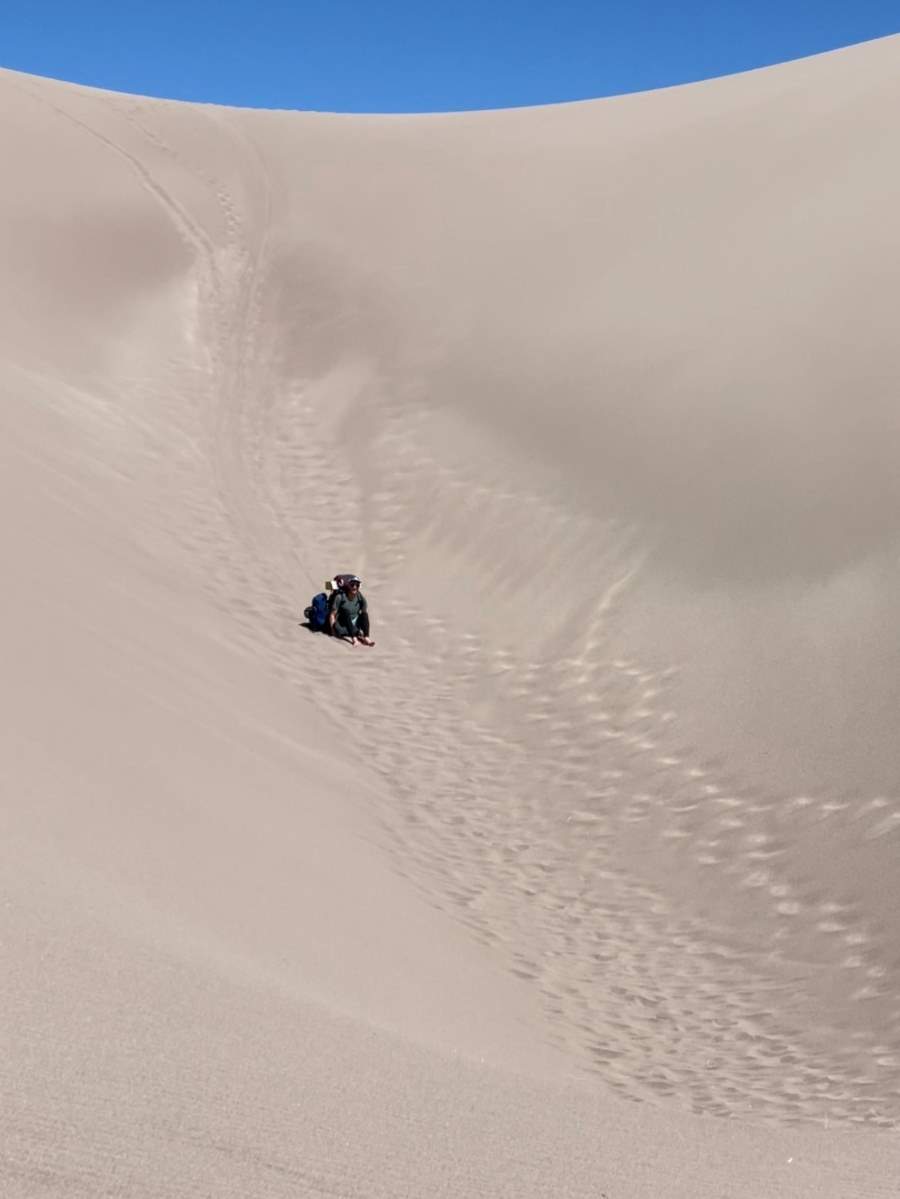

HIKE ZAPATA FALLS
Zapata Falls is only 15 minutes down the highway from the entrance of Great Sand Dunes National Park. It’s the perfect addition to your Sand Dunes visit. You do need to drive 3.5 miles up a rough dirt road to access the trail but most cars were able to make the trek. The hike is an easy, but rocky, 1 mile out and back hike with a big payoff. In the first weekend of May, we were lucky to see the falls partially frozen. If you’re feeling adventurous (and lucky!), you can camp at the first come-first serve Bureau of Land Management campsites at the trailhead and along the approach road. Those sites appeared to have incredible views of the Great Sand Dunes from above.
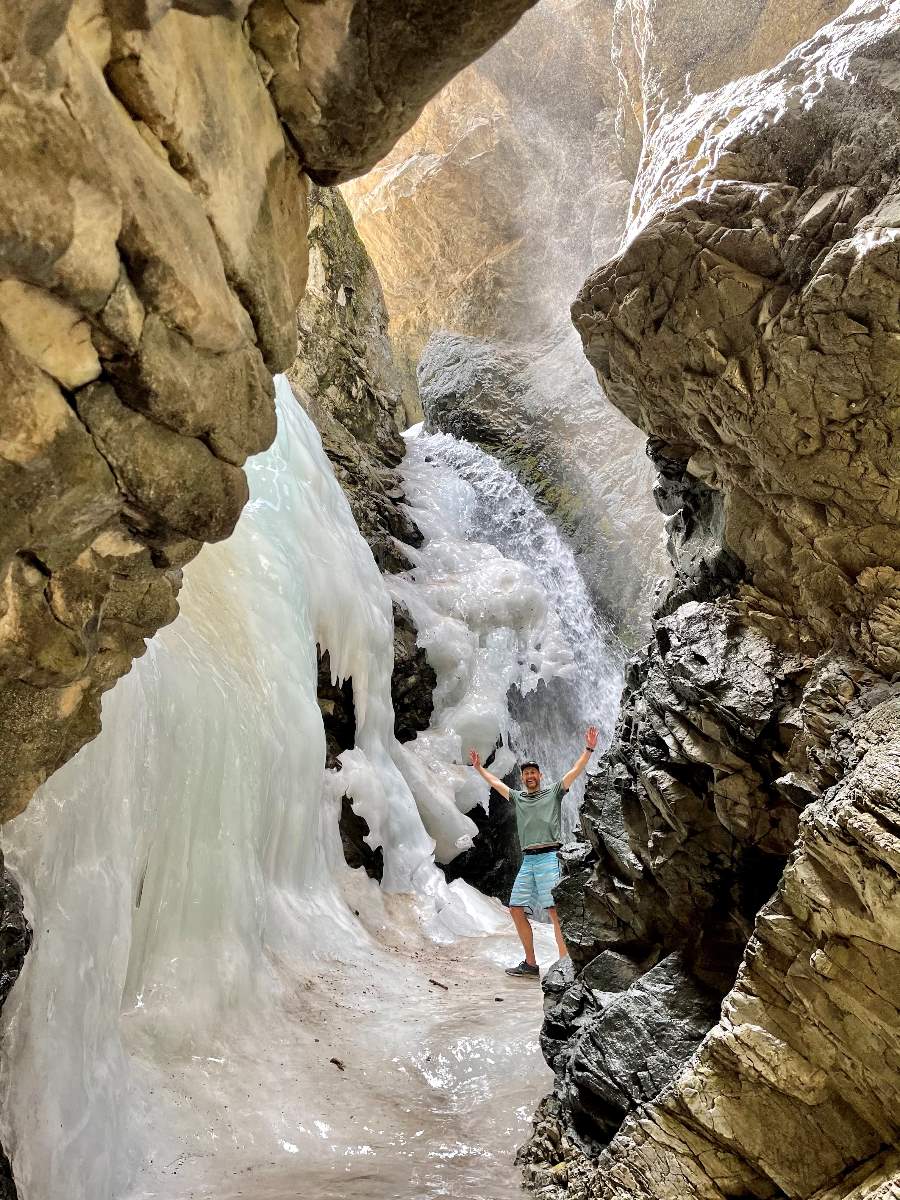
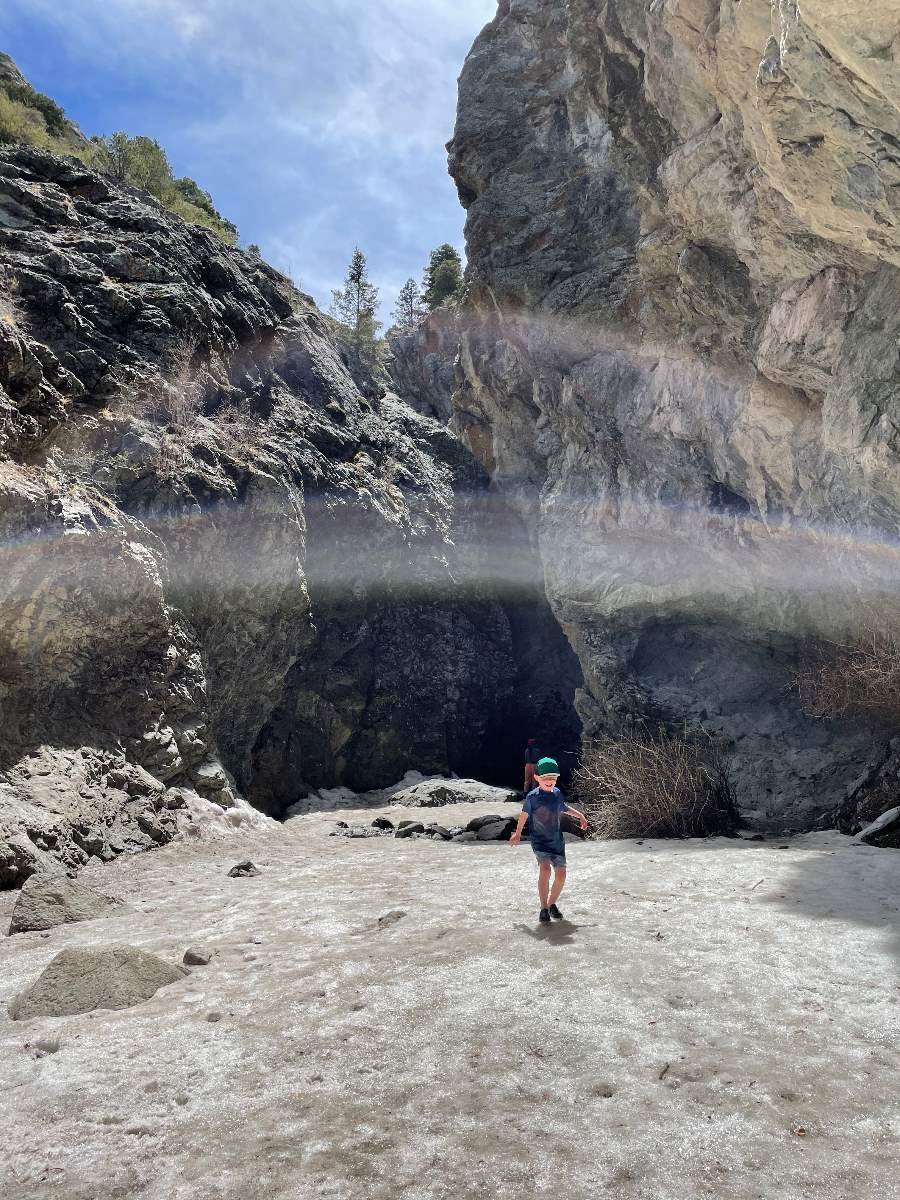
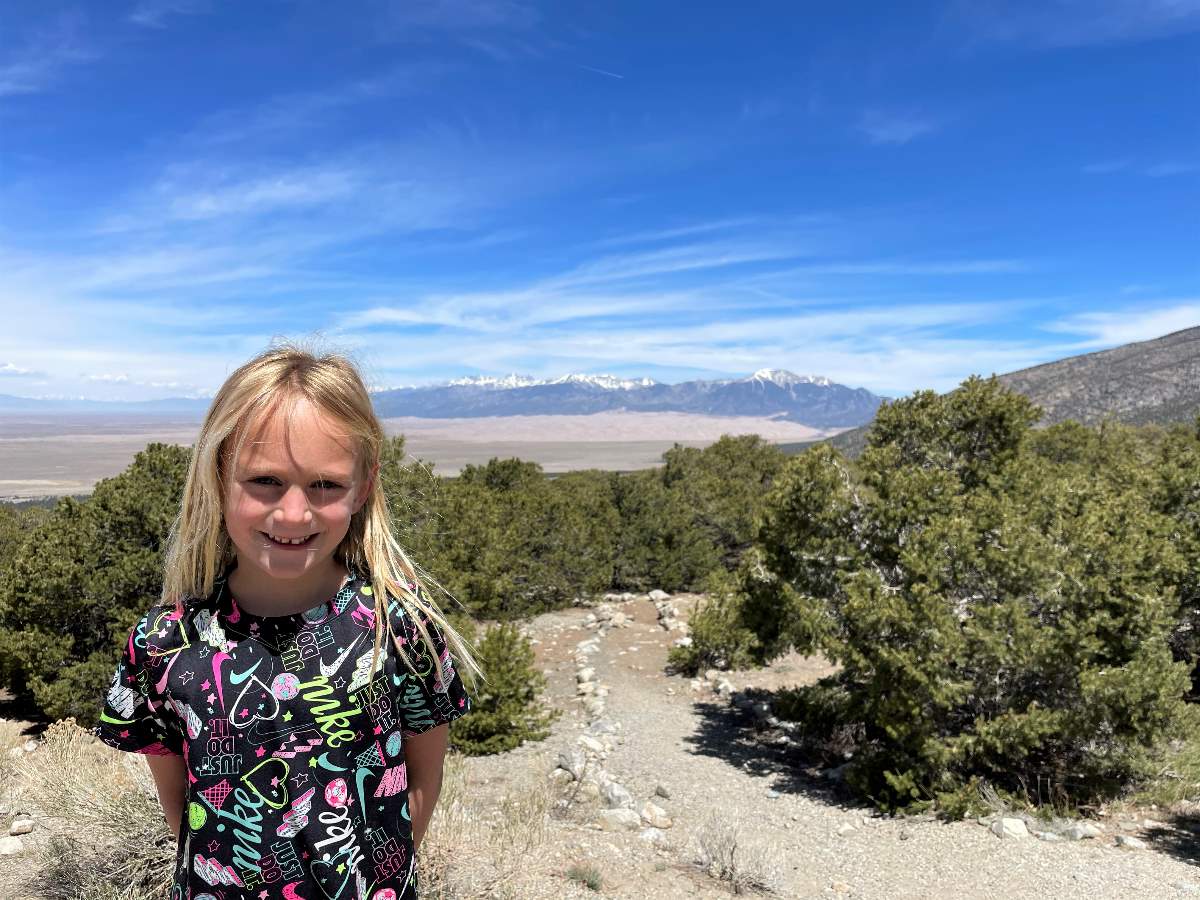
DRIVING DIRECTIONS TO GREAT SAND DUNES NATIONAL PARK FROM ALAMOSA, COLORADO
From Alamosa, the closest town, head East on Highway US-160 for 0.5 miles. Turn left on CO150 North for 34 miles. Once you are in the park boundaries, take the second left on Medano Creek Road and park in the Dunes Parking lot.
Is this National Park on your list? Would you consider backpacking in the park or would you rather sled and play in the creek? Either way, you are sure to have a fantastic and unique time! Check out more of our National Park adventures here!
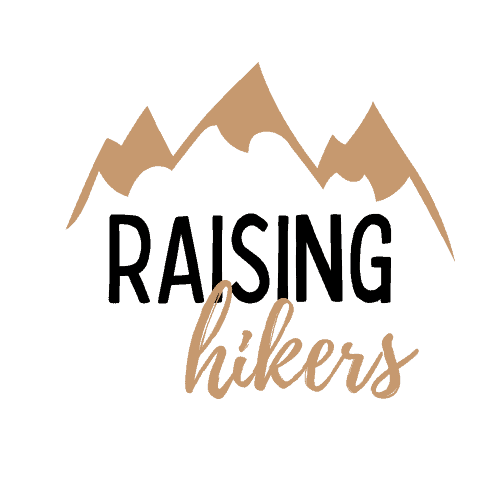






















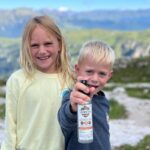
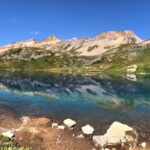
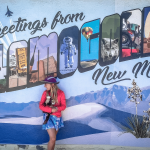
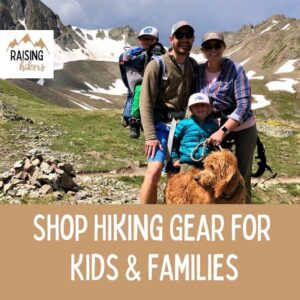
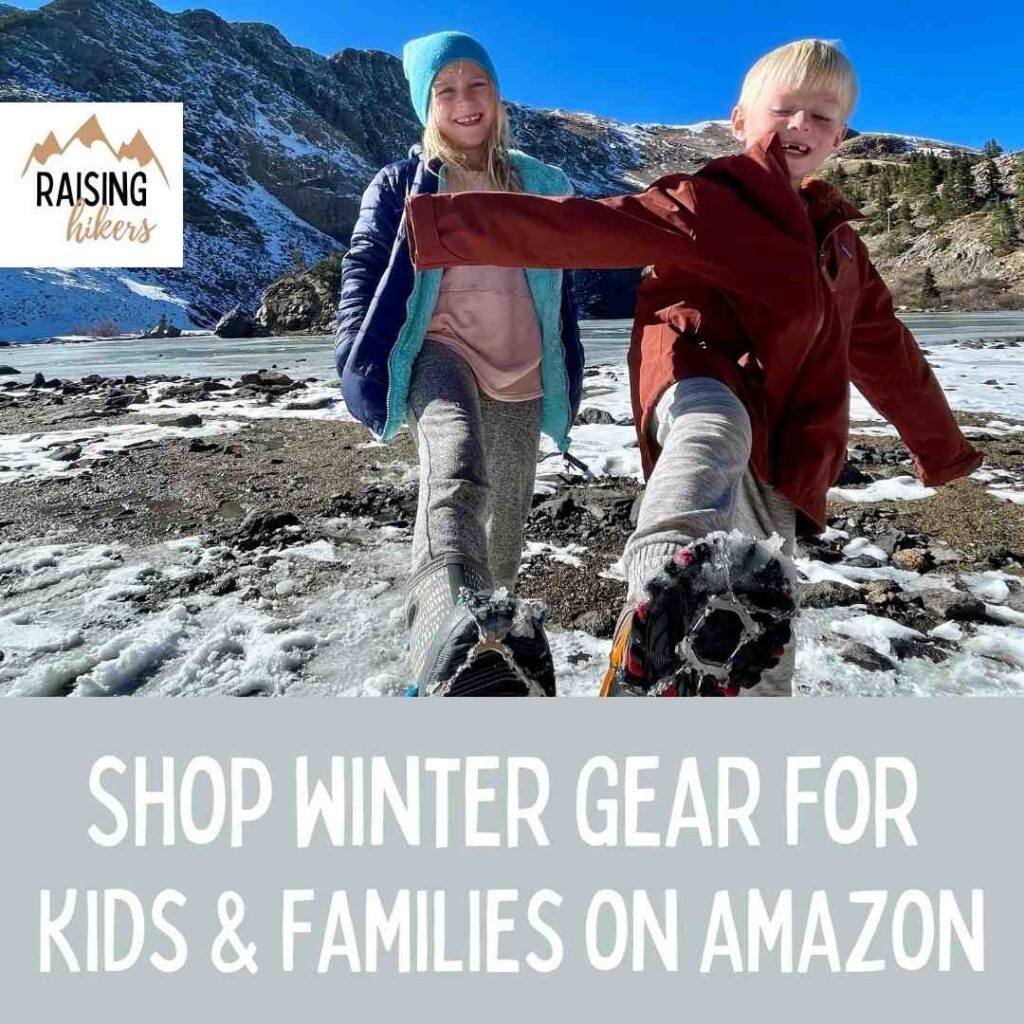

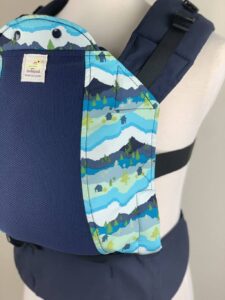






How awesome! I’ve been to the sand dunes in Arizona but not these in Colorado! So beautiful.
Planning is so crucial! Looks like a great time was had by all!
Yes, it makes a big difference! Although I did pack the night before. LOL.
How did you navigate? Were there markers to help you get back to the parking lot from back country area and day use area?
Great question since there really isn’t a “trail” on the dunes. We used our AllTrails and Strava, but not following a specific trail on the way there, just so that we had that safety net on the wayback. It’s actually very clear which direction you came from so you can easily head back the way you came. No markers or anything though, just a few notable dunes that help orient you.
You guys did it!! What an awesome accomplishment and a fantastic post. We chatted with you guys down in the creek just before your trek up. It was great to meet you and we’re so glad to know about your blog! All the best to you and we’ll be checking the blog often! What a great resource as we try to pack in a few more adventures this spring and summer!
Hi Maegan! I’m so glad you found us!!! It was so awesome getting to chat with you guys! Best of luck on the rest of your travels. Message me if you guys need any suggestions if you make it to WA or MT! 🙂
Great pictures! Such helpful tips. Thank you for sharing.
Thank you, Maya! Glad you found it helpful!
Great detail! This is a great guide for anyone with littles!
Thank you for reading!
Very informative. Thank you
Glad you found it helpful. Thanks for reading!
I would love to visit another sand dunes never heard there is one in Colorado, Ive only been to Denver and Co Spring, thanks for the tips 🙂
It’s definitely one for your list! I never knew about it until we moved here. Very very cool! Thanks for reading. 🙂
As many posts as I’ve seen on national parks, I didn’t realize you could camp in the dunes like that. Very cool.
It was such a unique experience and I agree…something I never knew was possible before!
LOL… you somehow made hiking through desert sand with minimal water and being sand blasted look and sound like a lot of fun!
In all seriousness though, it does look like an interesting overnight adventure and worth a try 😁
Haha, yeah, there were some “adventurous” parts to it for sure, but we all really did have fun!
You indeed do look like happy campers 😊
Regardless of how much sand was in the mug, we sure did!
So grateful you took the time to write and share so much detail. You answered every question I had, plus a bunch of stuff I’m usually embarrassed to ask (everybody seems to know already but I’m still learning!) Thank you THANK YOU!!
No embarrassing questions about being the outdoors! I’m glad you found my resource helpful! Thanks for reading.
Great information! We do a lot of national parks as we travel full-time. We haven’t hiked there yet but you provided all the details we need to plan it!! Thank you for sharing.
I hope you are able to make it there! Glad you found my write up helpful! Thanks for reading. 🙂
Such a detailed guide! Would love to hike in Sand Dunes National Park. In fact, its already on my list! LOL. What an amazing adventure you had!
Yay! I’m so glad it made your list! Your kids will have a blast!
Oh gosh! Reading your blog is like reading an adventure book but it is more interesting because it’s all true. Love it!
Ha, that’s the best compliment ever. Glad you enjoyed it. Thank you!!
Hiking in the sand is so much harder. My kids would love playing too!
So much harder!! One step forward, two steps back! But lots of steps of fun.
First off, congratulations on completing such an amazing feat! Thank you for sharing this adventure and your tips for backpacking. We haven’t done or planned a backpacking trip yet, but we may need to give this a try in the future!
Thank you so much!
I’m so happy the wind died down for the night. Tent camping in extreme wind can be a very scary experience.
I was so worried that no one was going to sleep a wink and it ended up being the most peaceful night’s sleep. Phew!!!
What a great trip for the kids! I’m sure they’ll have fond memories of it!
I think they will remember it forever…I definitely will!
I love hiking! I will definitely be referring to this post when packing for my trip! Really informative.
I’m glad you found it helpful! Let me know if you have any questions before your visit!
This National Park looks awesome! And just look at the kids go. I love the sunset pictures. The no trail thing would make me nervous though! I will be adding this one to my bucket list and using all these tips. Thank you.
It’s definitely different having no trail but it was kind of freeing! I’m glad it’s made your list! You’ll love it. And you should definitely camp up at Zapata Falls with your overland rig!
Wow this is so adventurous! What a great family memory. I never thought about not being able to stake down the tent – sounds like a challenge but still worth it.
Totally worth it, but was definitely a challenge!
We stumbled upon Great Sand Dunes just last month while driving from Grand Junction to Santa Fe. We didn’t know it existed prior to that! So glad we stopped in. It was a pleasant surprise to find and beautiful weather the day we visited. Very fun to read this after just having visited!
That’s awesome!! You definitely made the right call! Thanks for reading. 🙂
Wow what a trek. You guys are amazing. I really loved how your daughters jacket popped with the sunset, such pretty photos.
I’m going to be sad when she grows out of that jacket. The sunset was the best memory ever.
That is awesome that you did that with kids!!! I haven’t done any Backcountry camping yet…still slighly hesitant to go without someone that has done it before lol
I totally get that! I’m very fortunate that my husband is an experienced backpacker. We hope to spread our knowledge and experience to help others gain that confidence!
Such a great comprehensive guide. Very informative! Thanks!
Glad you found it helpful! Thank you for reading.
What a unique and stunning camping trip! And very brave of you to do it with your children! This would be a place I would love to visit someday, thank you for the great information in your post!
I hope you do get a chance to visit one day!
Even, with getting sand in every crevice of the body. I still think this would be a fantastic way to hike. Thanks for sharing.
Totally! We had to do quite a bit of sweeping after we unpacked but it was still worth it!
Wow! That looks like such an amazing trip. Your pictures are beautiful. Thank you for all the great information… This is definitely on my list. It’s such a unique location. Congratulations to the kids for their first overnight backpack!!
Thank you so much, Denise! I’m glad it’s on your list! You’ll love it, so different than the “usual” scenery.
Wow, such detail! Thanks!
You are welcome! Hope it helps in your trip planning! Let me know if you have any questions. 🙂